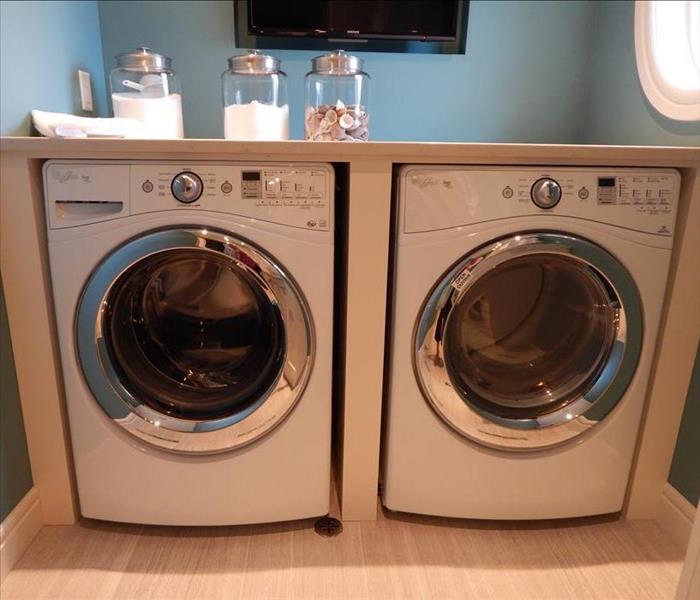Recent Water Damage Posts
Sewer Line Backup: Your #1 Guide to Effective Restoration
3/31/2025 (Permalink)
 The professionals at SERVPRO are available 24/7 to help combat sewage damage!
The professionals at SERVPRO are available 24/7 to help combat sewage damage!
This comprehensive sewer line backup resource provides expert insights and practical steps to protect your property and restore it efficiently after an unexpected backup.
A sewer line backup is one of the most disruptive and unpleasant issues property owners can face. When a sewer system becomes clogged or damaged, wastewater can flow back into your home or business, causing extensive damage to floors, walls, and valuable belongings. The impact is not just messy—it can also compromise the structural integrity of your property and disrupt daily life.
This blog post will explore the common causes of sewer line backups, outline preventative measures, and highlight how SERVPRO® experts can restore your property swiftly and effectively.
What Causes a Sewer Line Backup?
Several factors contribute to sewer line backups, with the most common being:
- Tree Root Intrusion: Over time, tree roots can grow into sewer lines, causing blockages and damage to pipes.
- Clogs from Debris and Grease: Flushing non-biodegradable items like paper towels, wipes, and excessive grease can cause severe blockages.
- Aging Sewer Systems: Older pipes are prone to corrosion and collapse, leading to frequent backups.
- Heavy Rainfall or Flooding: Excessive rain can overload municipal sewer systems, pushing water back into homes and businesses.
- Pipe Damage or Blockages: Structural issues such as pipe collapses, cracks, or shifting due to soil movement can obstruct wastewater flow.
Understanding these causes can help property owners take preventative measures to reduce the risk of a sewer line backup disaster.
How Can a Sewer Backup Damage Your Property?
A sewer line backup can cause significant and costly property damage. When wastewater overflows into a building, it can:
- Soak carpets, flooring, and drywall, leading to structural damage.
- Compromise the integrity of wood and furniture.
- Damage electrical systems if water reaches outlets and appliances.
- Result in lingering odors that require specialized deodorization treatments.
Timely intervention is crucial to mitigate damage and restore your property efficiently.
Prevention Tips to Avoid a Sewer Line Backup
Taking proactive steps can help prevent sewer line backups from occurring. Here are some practical measures:
- Dispose of Waste Properly: Avoid flushing wipes, diapers, paper towels, and other non-degradable items down the toilet.
- Regular Drain Maintenance: Use drain strainers to catch debris and schedule periodic drain cleanings.
- Limit Grease Disposal: Instead of pouring grease down the drain, collect it in a container and dispose of it in the trash.
- Inspect Your Sewer Line: Regularly check for signs of pipe damage or root intrusion and schedule professional inspections as needed.
- Install a Backwater Valve: This device prevents sewage from flowing back into your home during heavy rain or municipal sewer overflow.
- Know Your Sewer Line’s Condition: Consider replacing outdated pipes with more durable materials if you have an older sewer system.
- Direct Rainwater Away: Ensure that your property’s drainage systems divert rainwater away from your foundation and sewer system to reduce overload risk.
Implementing these precautions can significantly lower the chances of experiencing a sewer line backup emergency.
A Recent Sewer Line Backup Emergency in Beavercreek, Ohio
Last week, in Beavercreek, Ohio, a local homeowner faced a distressing situation when their basement flooded due to a sewer line backup. A blockage in the main sewer line caused wastewater to overflow into the lower level of their home, soaking carpets, damaging furniture, and creating a major cleanup challenge.
As soon as we received the call, our SERVPRO team mobilized immediately. Understanding the urgency of a sewer line backup, we arrived on-site promptly to assess the damage and implement a strategic restoration plan:
1. Immediate Water Extraction
Our team used industrial-grade extraction equipment to remove standing wastewater, preventing further damage and halting the spread of contaminants.
2. Thorough Cleaning and Sanitization
After extracting the water, we applied specialized cleaning agents to disinfect affected surfaces, ensuring that all contaminants were neutralized.
3. Advanced Drying and Dehumidification
We deployed high-powered air movers and dehumidifiers to prevent moisture-related structural issues, eliminating any residual dampness.
4. Odor Removal and Air Purification
Sewer backups often leave persistent odors. We utilized professional-grade air scrubbers and deodorizers to restore fresh indoor air quality.
5. Damage Assessment and Restoration
Our team evaluated any structural damage and replaced compromised materials, ensuring that the home was fully restored to preloss condition.
This incident in Beavercreek, Ohio, highlights the importance of rapid response and expert intervention in handling sewer line backup emergencies.
What Should You Do If You Experience a Sewer Line Backup?
If you encounter a sewer line backup, taking immediate action is key to minimizing damage. Here’s what you should do:
- Stop Using Water: Cease using sinks, toilets, and appliances that drain into the sewer line to prevent further backup.
- Evacuate the Affected Area: Avoid walking through contaminated water to reduce damage to belongings and flooring.
- Turn Off Electricity (If Safe to Do So): If the backup reaches electrical outlets, shut off power to prevent hazards.
- Call SERVPRO for Professional Restoration: Our team is available 24/7 to respond quickly and restore your property with precision and expertise.
- Document the Damage: Take photos and record details for insurance claims.
- Open Windows for Ventilation: Increasing airflow can help reduce odors and excess moisture.
Why Choose SERVPRO for Sewer Line Backup Restoration?
SERVPRO is a trusted leader in property restoration, specializing in sewer line backup cleanup and recovery. Our highly trained professionals use state-of-the-art equipment and industry-leading techniques to:
- Provide rapid emergency response to minimize damage.
- Deliver comprehensive cleaning, drying, and sanitization services.
- Use advanced deodorization methods to eliminate persistent odors.
- Work with your insurance company to simplify the claims process.
Wrapping Up
A sewer line backup can be a frustrating and overwhelming experience. Still, with the proper preventive measures and professional support, property owners can minimize damage and restore their spaces efficiently. SERVPRO's expert restoration team is ready to respond immediately, ensuring a thorough and effective cleanup process.
If you ever face a sewer line backup, don’t wait—contact SERVPRO immediately to restore your property and peace of mind. With advanced techniques, rapid response, and a commitment to excellence, we are here to make it “Like it never even happened.”
Sump Pump Failure: 5 Expert Steps to Effective Restoration
1/13/2025 (Permalink)
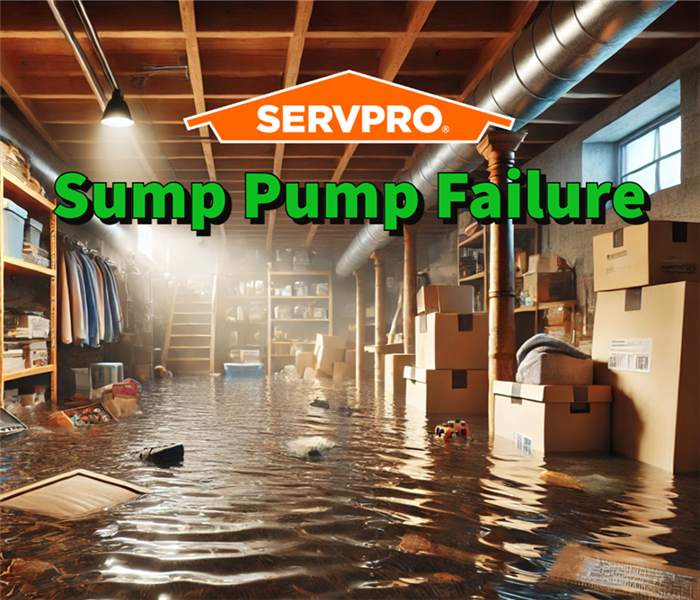 The professionals at SERVPRO are available 24/7 to help combat water damage!
The professionals at SERVPRO are available 24/7 to help combat water damage!
Learn How to Address Sump Pump Failure and Minimize Water Damage!
Sump pump failure is one of the most daunting challenges homeowners face during heavy rains or floods. Water can quickly infiltrate your basement or crawlspace when this critical device malfunctions, leading to extensive property damage.
This blog post dives into common causes of sump pump failure, offers actionable prevention tips, and highlights how SERVPRO® can assist in restoring properties affected by water damage due to sump pump issues.
What Causes Sump Pump Failure?
Sump pumps are designed to protect your property by redirecting water away from your foundation. However, failures can occur for several reasons:
- Power Outages: Most sump pumps rely on electricity. Severe storms often result in power outages, leaving your sump pump nonfunctional when needed most.
- Improper Installation: Poor installation or a pump incorrectly sized for your home can lead to operational failures.
- Clogged Components: Debris in the discharge pipe or the pump itself can block water flow, causing the pump to fail.
- Lack of Maintenance: Over time, wear and tear can affect the pump's performance. Without regular inspections, small issues can escalate.
- Overwhelmed System: A single sump pump might struggle to handle heavy rainfall or flooding, especially in areas prone to water accumulation.
Understanding these causes is the first step in protecting your property from the fallout of a sump pump failure.
Tips to Prevent Sump Pump Failure
Preventing sump pump failure requires proactive measures and regular maintenance. Here are some expert tips to keep your sump pump in top condition:
- Install a Backup Power Source: Use a battery backup or generator to ensure your sump pump operates during power outages.
- Test Your Pump Regularly: Pour water into the sump pit periodically to ensure the pump activates and drains the water efficiently.
- Clean the Pump and Pit: Remove debris from the pump, pit, and discharge pipe to avoid clogs that could disrupt water flow.
- Upgrade Your Pump: If you live in a flood-prone area, consider installing a more robust pump or adding a secondary pump.
- Inspect Discharge Lines: Ensure discharge lines are free from blockages and positioned to direct water safely away from your foundation.
- Invest in a High-Quality Pump: Opt for a durable, high-capacity pump suited to your property's needs.
- Install Water Alarms: Water sensors can alert you to flooding or pump failure before it escalates.
These steps can significantly reduce the sump pump failure risk and protect your home from water damage.
A Recent Sump Pump Failure Emergency
Last month, in Dayton, Ohio, a local homeowner faced significant water damage due to a sudden sump pump failure during a heavy rainstorm. The pump, overwhelmed by the volume of water, stopped working, causing the basement to flood.
Upon receiving the call, our SERVPRO team quickly mobilized and arrived on-site within hours. Here's how we handled the situation:
- Rapid Water Extraction: Using advanced water extraction equipment, we removed standing water to minimize further damage.
- Drying and Dehumidification: We deployed industrial-grade air movers and dehumidifiers to thoroughly dry the basement, focusing on hidden moisture in walls and flooring.
- Cleaning and Sanitizing: Our team cleaned and sanitized the affected area, preventing potential long-term issues like odors or structural weakening.
- Restoration Planning: We assessed the damage and provided a comprehensive restoration plan, ensuring the property would be fully restored to its preloss condition.
- Preventive Advice: To help the homeowner avoid future issues, we recommended installing a backup power system and regularly inspecting the pump.
This homeowner in Dayton, Ohio, experienced firsthand the efficiency and professionalism of SERVPRO.
What to Do When Your Sump Pump Fails
If you experience a sump pump failure, take the following steps immediately:
- Stop Water Entry: If possible, identify and stop the water source.
- Turn Off Power: Ensure safety by turning off electricity to the affected area before entering.
- Contact SERVPRO: Reach out to our water damage restoration experts for prompt assistance.
- Move Valuable Items: Relocate furniture and belongings to prevent further damage.
- Document the Damage: Take photos and videos for insurance purposes.
Time is critical in mitigating water damage, so don't delay in seeking professional help.
Why Choose SERVPRO for Sump Pump Failure Restoration?
SERVPRO is a trusted leader in water damage restoration. Our team combines advanced technology with industry expertise to deliver effective solutions. Here's what you can expect when you choose SERVPRO:
- 24/7 Emergency Response: We're available around the clock to assist you during emergencies.
- Cutting-Edge Equipment: Our water extraction and drying equipment ensures thorough restoration.
- Trained Professionals: Our technicians are IICRC-certified and experienced in handling complex water damage scenarios.
- Customized Solutions: We tailor our restoration approach to your specific needs, ensuring optimal results.
With SERVPRO, you're not just getting a service—you're gaining a partner dedicated to protecting your property.
Final Thoughts
Sump pump failure can cause significant disruption and damage, but you can minimize its impact with proactive measures and professional assistance. Whether you're looking to prevent failure or need expert restoration services, SERVPRO is ready to help.
When water damage strikes, don't face it alone. Contact SERVPRO today, and let us restore your peace of mind.
Preparation and quick action are your best defenses against sump pump failure.
Washing Machine Overflow: 6 Expert Tips to Prevent Damage
10/28/2024 (Permalink)
 The professionals at SERVPRO are available 24/7 to help combat water damage!
The professionals at SERVPRO are available 24/7 to help combat water damage!
Discover expert tips and restoration solutions to protect your home from water damage caused by washing machine overflow.
Washing machines are a staple in homes nationwide, providing convenience and efficiency. However, a washing machine overflow can quickly turn this convenience into a source of frustration and extensive water damage. When water spills over, it can damage your property's floors, walls, and other areas.
This guide explores the causes of washing machine overflow, prevention strategies, and how SERVPRO® can help restore your home when accidents happen.
What Causes A Washing Machine Overflow?
Understanding the reasons behind washing machine overflows can help prevent costly water damage. Here are some common culprits:
- Faulty Inlet Valves: These valves control the water flow into the washing machine. When they malfunction, they may allow excessive water into the drum, leading to overflow.
- Blocked or Kinked Drain Hoses: If the drain hose is clogged or kinked, it prevents water from draining properly, causing it to back up and overflow.
- Overloading the Machine: Excessively loading the machine can strain its system, leading to malfunction and, ultimately, overflow.
- Detergent Buildup: Over time, detergent residues can accumulate in hoses, restricting water flow. This blockage can lead to an overflow during the rinse cycle.
What Should You Do If a Washing Machine Overflows?
Quick action is essential to reduce damage caused by a washing machine overflow. Here are immediate steps to take:
- Turn Off the Power: For safety, disconnect the washing machine from its power source to prevent electrical hazards.
- Stop the Water Supply: Turn off the machine's water supply to stop further flooding.
- Contain the Water: Use towels, mops, or any absorbent material to contain the water within the immediate area and prevent further spread.
- Contact SERVPRO: Once the situation is contained, call a professional restoration team to evaluate and restore the affected areas.
6 Pro Tips to Prevent Washing Machine Overflow
Preventing washing machine overflow is achievable with proactive measures. Here are expert tips to reduce the risk:
- Regularly Inspect the Hoses: Every few months, check the hoses for signs of wear, cracks, or blockages. Replace any hoses showing damage.
- Avoid Overloading: Follow the manufacturer's recommendations regarding load capacity to avoid placing excessive strain on the machine.
- Use the Right Detergent: Always use high-efficiency (HE) detergent if your machine requires it to prevent excessive suds, which can cause overflow.
- Clean the Detergent Dispenser: Remove detergent buildup by periodically cleaning the dispenser tray.
- Install a Water Alarm: Consider installing a water leak detector near the machine. This device alerts you if water is detected outside the machine, allowing you to respond promptly.
- Schedule Regular Maintenance: Regular servicing by a professional can identify and resolve potential issues before they lead to overflow.
Real-Life Restoration: A Recent Incident in Beavercreek, Ohio
Recently, a homeowner in Beavercreek, Ohio, contacted us after experiencing severe water damage due to a washing machine overflow. This unfortunate event caused significant water spread, affecting the laundry room and adjacent areas. SERVPRO promptly responded, assessing the extent of the water intrusion and determining the best restoration approach.
Our expert team followed these critical steps to ensure a thorough and efficient recovery:
- Water Extraction: We used specialized equipment to remove standing water quickly, preventing further absorption into the floors and walls.
- Drying and Dehumidification: High-powered drying equipment and dehumidifiers were set up to remove moisture from visible and hidden areas.
- Surface Sanitization: Once the affected areas were dry, we disinfected surfaces to prevent bacterial growth and eliminate any odors caused by stagnant water.
- Moisture Monitoring: We verified that all areas were thoroughly dried using advanced moisture detection tools, reducing the risk of mold growth or structural issues in the future.
This incident in Beavercreek, Ohio, demonstrates the importance of timely intervention and the value of a professional restoration team. SERVPRO mitigated the damage efficiently, helping the homeowner restore their property with minimal disruption.
How SERVPRO Can Assist in Washing Machine Overflow Restoration
When washing machine overflow occurs, professional assistance is essential. SERVPRO offers various services to restore and protect your home from future water-related issues. Here's how we can help:
- Fast Response Time: SERVPRO is available 24/7, so you don't have to wait long to address your emergency. Quick response limits water damage, reducing the need for extensive repairs.
- Specialized Equipment: Our state-of-the-art water extraction and drying equipment removes water and moisture from hard-to-reach areas.
- Certified Technicians: Our trained technicians have extensive experience handling water damage and will ensure your property is restored to its pre-damage condition.
- Comprehensive Restoration Plan: SERVPRO assesses each situation individually, providing a customized plan that includes water extraction, drying, dehumidification, sanitization, and final inspections.
Prevent Future Washing Machine Overflows with Smart Upgrades
Preventative upgrades can safeguard your property from potential washing machine overflows. Consider these smartadditions:
- Automatic Shutoff Valves: These valves detect when the water level exceeds normal limits and automatically shut off the water supply to prevent overflow.
- Reinforced Hoses: Replacing standard hoses with braided stainless steel options provides added durability and reduces the risk of hose failure.
- Drain Pan Installation: Placing a drain pan underneath the machine captures any overflow, guiding water to the drain rather than allowing it to spread.
Wrapping Up: Trust SERVPRO for Washing Machine Overflow Restoration
Washing machine overflows can happen unexpectedly, causing disruption and costly damage. You can protect your property from extensive water damage by taking preventative measures and knowing what to do when an overflow occurs. If one does occur, SERVPRO is here to provide comprehensive restoration solutions. From quick water extraction to detailed moisture monitoring, we ensure your home is fully restored and safeguarded from future issues.
Choosing SERVPRO for washing machine overflow restoration means more than just cleanup; it provides you with a trusted partner in property protection. With our swift response, advanced techniques, and dedication to customer satisfaction, you can rely on us to guide you through every step of the restoration process. Washing machine overflows can be challenging, but with SERVPRO by your side, your home is in expert hands.
Emergency Water Extraction: #1 Guide to Effective Recovery
8/12/2024 (Permalink)
 The professionals at SERVPRO are ready to help you combat water damage with 24/7 emergency water extraction services!
The professionals at SERVPRO are ready to help you combat water damage with 24/7 emergency water extraction services!
This essential emergency water extraction resource offers expert advice and proven methods to protect your property from extensive water damage.
Water emergencies can strike unexpectedly, leaving property owners overwhelmed and unsure of the next steps. Whether it's a burst pipe, a flooded basement, or an overflowing sink, the consequences of water damage can be severe and swift.
Rapid response and effective water extraction are critical to minimizing damage and restoring your property to its original condition. This comprehensive guide will delve into the importance of emergency water extraction, provide actionable tips, and illustrate how SERVPRO® can be your trusted partner in this crucial process.
What Is Emergency Water Extraction and Why Is It Essential?
Emergency water extraction is the process of removing standing water from your property as quickly as possible after a water intrusion event. This step is crucial to preventing further damage, such as structural weakening, mold growth, and deterioration of personal belongings.
Water damage can escalate rapidly if not addressed immediately. Within minutes, water spreads throughout your property, saturating everything in its path. Within hours, it begins to damage walls, floors, and furnishings, potentially leading to long-term structural issues.
The sooner you start the extraction process, the better the chances of salvaging your property and belongings.
Common Causes of Water Emergencies
Water emergencies can occur for various reasons, and understanding these causes can help you take preventive measures. Some common scenarios include:
- Burst Pipes: Pipes can burst due to freezing temperatures, age, or excessive pressure. A burst pipe can quickly release a large volume of water, causing extensive damage.
- Appliance Malfunctions: Water heaters, washing machines, and dishwashers can malfunction, leading to significant water leaks.
- Natural Disasters: Heavy rainfall, storms, and flooding can introduce large amounts of water into your property, overwhelm drainage systems, and cause severe water damage.
- Sewer Backups: Sewer line blockages can lead to wastewater backing up into your property, creating a hazardous and urgent situation.
The Critical Steps in Emergency Water Extraction
When faced with a water emergency, taking swift action is crucial. Here's a step-by-step guide to managing the situation:
Step 1) Stop the Water Source
The first step in any water emergency is to identify and stop the source of the water. If it's safe, shut off the main water valve to prevent further water intrusion.
Step 2) Ensure Safety
Before entering the affected area, ensure that the environment is safe. Water can create electrical hazards, so turn off the power supply to the affected areas if necessary.
Step 3) Contact SERVPRO
Reach out to SERVPRO immediately. Our team is available 24/7 to respond to water emergencies. We understand the urgency and will mobilize our professionals to your location immediately.
Step 4) Water Extraction
Upon arrival, our team will assess the situation and begin the water extraction using advanced equipment such as industrial-grade pumps and wet vacuums. This step is vital to remove as much standing water as possible.
Step 5) Drying and Dehumidification
After water extraction, the drying process begins. SERVPRO utilizes high-speed air movers and dehumidifiers to remove moisture from the air and materials, preventing further damage and mold growth.
Step 6) Cleaning and Sanitizing
Once the area is dry, thorough cleaning and sanitizing are essential to remove contaminants and prevent mold growth. SERVPRO uses specialized cleaning products and techniques to ensure your property is safe and clean.
Step 7) Restoration
The final step is restoring your property to its pre-damage condition. Depending on the extent of the damage, this may involve minor repairs such as replacing drywall or major reconstruction projects.
Scenario: Emergency Water Extraction in Beavercreek, Ohio
Last month, a severe water emergency occurred in Beavercreek, Ohio, underscoring the importance of prompt and professional water extraction. A local homeowner experienced a catastrophic event when a washing machine hose burst in the middle of the night, flooding the entire first floor of their home.
The homeowner awoke to several inches of water throughout the living room, kitchen, and hallway. Panic set in as they realized the potential damage to their hardwood floors, furniture, and personal belongings. They immediately called SERVPRO, knowing that time was of the essence.
Our SERVPRO team responded swiftly, arriving on-site within an hour. After assessing the situation, we quickly shut off the water source and began the extraction process. Using our powerful pumps and extraction tools, we removed the standing water, preventing it from seeping further into the walls and floors.
Next, our team deployed industrial air movers and dehumidifiers to dry the affected areas thoroughly. We continuously monitored the moisture levels to ensure no hidden water pockets remained, which could lead to mold growth later on.
In addition to water extraction and drying, we advised the homeowner on preventing future water emergencies, including regular appliance maintenance and the installation of water leak detectors.
Thanks to SERVPRO's quick action, the homeowner's property was saved from extensive damage, and they could return to their daily routine with minimal disruption.
5 Tips to Prevent Water Damage
While water emergencies can sometimes be unavoidable, preventive measures can reduce the likelihood of such events. Here are some tips:
- Regular Inspections: Regularly inspect plumbing, appliances, and your home's foundation for signs of wear or damage.
- Install Leak Detectors: Consider installing water leak detectors in high-risk areas like basements, laundry rooms, and kitchens.
- Maintain Your Roof and Gutters: Ensure your roof and gutters are in good condition to prevent water from entering your property during heavy rain.
- Upgrade Appliances: If your appliances are old or prone to malfunctions, consider upgrading to newer, more reliable models.
- Know Your Water Main: Familiarize yourself with the location of your water main and know how to shut it off in case of an emergency.
Why Choose SERVPRO for Emergency Water Extraction?
When disaster strikes, you need a trusted water damage restoration partner who can respond quickly and effectively. SERVPRO has been a leader in the water damage restoration industry for years, offering unmatched expertise, advanced technology, and a commitment to customer satisfaction.
- Rapid Response: Our teams are available 24/7, ensuring we can begin restoration as soon as possible.
- Advanced Equipment: We use the latest water extraction and drying equipment to handle even the most severe water emergencies.
- Experienced Professionals: Our technicians are highly trained in water damage restoration, ensuring that your property is in capable hands.
- Comprehensive Services: SERVPRO provides a complete solution to your water emergency needs, from water extraction to complete restoration.
Final thoughts
Emergency water extraction is critical in mitigating water damage and protecting your property. Swift action is essential to minimize the impact, whether it's a burst pipe, appliance malfunction, or natural disaster. SERVPRO is ready to help, offering rapid, professional services that can make a difference in the aftermath of a water emergency.
By following the tips provided and relying on SERVPRO for emergency water extraction, you can ensure that your property is restored quickly and effectively, with minimal disruption to your life. Trust SERVPRO to be your partner in protecting your home or business from the devastating effects of water damage.
Dehumidification: The #1 Guide to Effective Moisture Control
5/27/2024 (Permalink)
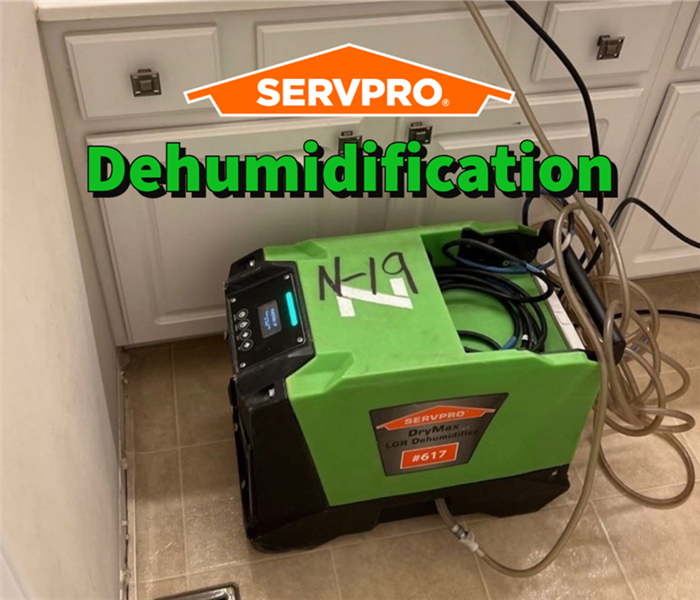 Understanding proper dehumidifier placement is essential for faster drying times!
Understanding proper dehumidifier placement is essential for faster drying times!
Expert insights and practical steps to safeguard your property from moisture-related damage in any season.
Moisture can wreak havoc on residential and commercial properties, leading to mold growth, structural damage, and compromised indoor air quality. Dehumidification is critical to property maintenance, ensuring that moisture levels remain controlled to prevent these adverse effects.
This blog post will delve into the importance of dehumidification, offer practical tips for maintaining optimal humidity levels, and highlight how SERVPRO® expertise can be invaluable in managing moisture and restoring properties affected by high humidity.
What is dehumidification, and why is it important?
Dehumidification is the process of removing excess moisture from the air to maintain an optimal indoor humidity level. Maintaining proper humidity is crucial for a few reasons:
- Mold Prevention: High moisture levels create an ideal environment for mold growth, which can damage property.
- Structural Integrity: Excess moisture can weaken building materials, leading to structural issues over time.
- Indoor Air Quality: Proper humidity levels contribute to better indoor air quality, reducing allergens and improving comfort.
- Preservation of Belongings: Many materials, such as wood and fabric, can deteriorate in high humidity, damaging furniture, electronics, and other possessions.
Common causes of high humidity
High humidity can result from various factors, including:
- Climate and Weather Conditions: Areas with high rainfall or temperatures can naturally have higher humidity levels.
- Poor Ventilation: Inadequate airflow in a building can trap moisture, leading to elevated humidity levels.
- Leaks and Water Intrusion: Leaky roofs, plumbing issues, and water intrusion from outside can increase indoor moisture levels.
- Everyday Activities: Cooking, showering, and breathing contribute to indoor humidity, especially in poorly ventilated spaces.
Tips to prevent and control high humidity
Preventing and controlling high humidity requires a combination of proactive measures and regular maintenance. Here are some practical steps to safeguard your property:
Use Dehumidifiers
Invest in dehumidifiers to regulate humidity levels, especially in areas prone to moisture buildup, like basements and bathrooms. Regularly empty and clean the units to maintain their efficiency.
Improve Ventilation
Ensure proper ventilation in all areas of your property. Use exhaust fans in kitchens and bathrooms to expel moisture-laden air. Consider installing a whole-house ventilation system for comprehensive air circulation.
Repair Leaks Promptly
Address any leaks in your property immediately. Regularly inspect your roof, plumbing, and foundation for signs of water intrusion and take swift action to repair any damage.
Insulate Pipes and Ducts
Insulate pipes and ducts to prevent condensation, which can contribute to higher humidity levels. Proper insulation also helps maintain consistent indoor temperatures.
Use Air Conditioners
Air conditioners help reduce indoor humidity by cooling the air and removing moisture. Ensure your air conditioning system is properly maintained and serviced regularly for optimal performance.
Monitor Indoor Humidity Levels
Use hygrometers to monitor indoor humidity levels. Aim to keep humidity between 30% and 50% to prevent mold growth and maintain a comfortable environment.
Maintain Gutters and Downspouts
Keep gutters and downspouts clean and in good repair to prevent water from accumulating near your property’s foundation, which can increase indoor humidity levels.
A recent dehumidification success story in Xenia, Ohio
Last month, SERVPRO was called to a historic home in Xenia, Ohio, with a severe moisture issue. The property, a cherished local landmark, had been experiencing persistent humidity problems, leading to visible mold growth and musty odors. This situation is a stark reminder of how uncontrolled moisture can threaten a property’s integrity and habitability.
Upon receiving the call, our SERVPRO team quickly mobilized to assess the situation. The home’s historic nature required a thorough approach. We conducted a comprehensive inspection, identifying several contributing factors, including inadequate ventilation and minor leaks in the basement.
Our action plan included:
- Immediate Mold Remediation: We safely removed the existing mold using specialized techniques to preserve the materials.
- Dehumidification Setup: We installed industrial-grade dehumidifiers to reduce moisture levels throughout the home rapidly. These units were strategically placed to maximize efficiency.
- Ventilation Improvements: We recommended and implemented enhancements to the home’s ventilation system, including installing exhaust fans in key areas and ensuring adequate airflow in the basement.
- Leak Repairs: Our team repaired the minor leaks in the basement, which had caused further water intrusion and subsequent humidity issues.
- Ongoing Monitoring: We set up a monitoring system to track humidity levels and ensure they remained within the optimal range. Our team also guided the homeowners on maintaining proper humidity levels moving forward.
This incident in Xenia, Ohio, exemplifies the importance of professional intervention in dehumidification and moisture control. Our swift response and expert solutions addressed the immediate issue and safeguarded the home against future humidity-related problems.
What should you do when you experience high humidity and moisture problems?
Immediate action is crucial when dealing with high humidity and moisture issues. Start by identifying and eliminating the source of excess moisture. Contact a professional restoration team, like SERVPRO, for a thorough assessment and tailored dehumidification solutions. While waiting for professional help, use dehumidifiers and improve ventilation to reduce moisture levels.
Wrapping up
SERVPRO’s reputation in dehumidification and moisture control is built on swift response, advanced technology, and skilled professionals. We understand the nuances of humidity and its critical role in property maintenance and restoration. Our team is trained to handle complex scenarios, ensuring efficient and effective moisture control solutions.
Choosing SERVPRO for dehumidification offers more than just immediate relief—it provides long-term protection for your property. Our quick response, cutting-edge techniques, and customer-centric approach make us a trusted ally in navigating the challenges of high humidity. With preparation and the support of SERVPRO professionals, your property can remain safe and comfortable, free from the adverse effects of excess moisture.
By following these tips and relying on professional expertise, you can effectively manage humidity levels in your property, ensuring a healthy and safe environment. Whether dealing with everyday humidity challenges or significant moisture problems, SERVPRO is here to help with comprehensive dehumidification and restoration services.
Fight Plumbing Backups: Our Best Advice In 5 Proactive Steps
3/11/2024 (Permalink)
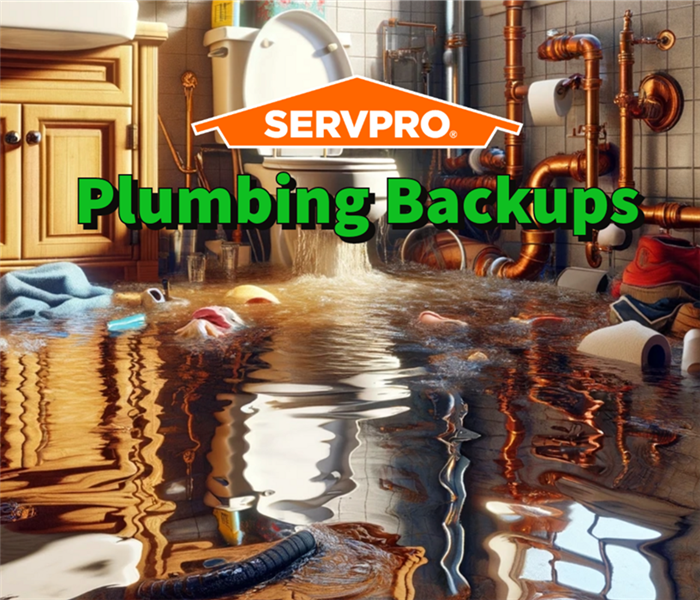 The professionals at SERVPRO always respond to water damage disasters caused by plumbing backups!
The professionals at SERVPRO always respond to water damage disasters caused by plumbing backups!
Discover our ultimate guide for managing plumbing backups and protecting your property.
Plumbing backups are more than a mere inconvenience; they represent a significant threat to the safety and integrity of your property. In Beavercreek, Ohio, where the charm of suburbia meets the unpredictability of seasonal changes, residents often face the daunting challenge of maintaining plumbing systems to prevent disastrous backups.
This comprehensive guide explores the root causes and prevention strategies for plumbing backups and illustrates how SERVPRO's unparalleled expertise can swiftly restore normalcy in the wake of such events.
Understanding the causes of plumbing backups
A plumbing backup occurs when wastewater is obstructed and forced back into the home, leading to potential flooding, property damage, and the risk of contamination. Various culprits can trigger these backups, including clogged drains, tree root infiltration, damaged sewer lines, and overwhelmed municipal sewer systems.
The complexity of these systems means that a backup can be an alarming signal of underlying issues demanding immediate and knowledgeable intervention.
The Beavercreek Predicament: A Plumbing Backup Saga
Imagine a serene evening in Beavercreek, Ohio, disrupted by the sudden emergence of water flooding your basement floor. This scenario became a reality for a local family when their main sewer line succumbed to a blockage caused by tree roots. This situation led to a significant plumbing backup during a family reunion. The swift intrusion of water threatened the structure of their home and posed immediate risks to their health and the continuity of their cherished gathering.
The family contacted SERVPRO® upon detecting the issue. Our team arrived promptly, understanding the urgency of mitigating the water damage and restoring the property to its pre-damage condition. This incident underscores the unpredictability of plumbing issues and the importance of having a reliable partner ready to tackle such emergencies.
Fortifying your fortress: Tips to prevent plumbing backups
Preventing plumbing backups requires vigilance and proactive measures. Here are strategies every homeowner should consider:
- Regular inspections and maintenance: Regularly inspect and maintain your plumbing system to identify and rectify potential problems before they escalate.
- Wise waste disposal: Be mindful of what goes down your drains. Avoid flushing anything besides human waste and toilet paper; never pour grease down the kitchen sink.
- Tree root management: Plant trees away from your sewer lines or opt for sewer-safe landscaping alternatives to prevent roots from damaging your pipes.
- Backwater valve installation: Installing a backwater prevention valve can significantly reduce the risk of sewer backups during heavy rainfalls or municipal sewer overflows.
- Upgrade your pipes: If you live in an older home, consider upgrading your pipes and sewer lines to modern materials less prone to corrosion and blockage.
When disaster strikes: SERVPRO to the rescue
Immediate action is crucial in the event of a plumbing backup. SERVPRO's emergency response teams are equipped to handle such crises with precision and speed. Our process includes:
- Rapid assessment and response: Our experts quickly assess the situation, identifying the backup water's source and the extent of the damage.
- Advanced water extraction techniques: We employ state-of-the-art water extraction methods to remove standing water efficiently, minimizing secondary damage to your property.
- Thorough cleaning and sanitization: Our team performs comprehensive cleaning and sanitization of affected areas to ensure your home is safe and free from contaminants.
- Drying and dehumidifying: Our industrial-grade dehumidifiers and air movers target moisture, crucial in preventing mold growth and further damage.
- Restoration and repair: We don't just clean up; we restore. From minor repairs to major renovations, we aim to return your property to its pre-backup condition.
Beyond the call: The SERVPRO advantage
Choosing SERVPRO for your plumbing backup and water damage services means more than just a quick fix; it's a partnership with a leader in the restoration industry. Our commitment to rapid response, advanced technology, and comprehensive solutions ensures that your property is in capable hands. We understand the stress and disruption caused by plumbing backups, so our team is dedicated to providing empathetic, efficient, and effective services tailored to your specific situation.
Preparation meets opportunity: safeguarding your home
While plumbing backups can be unpredictable, being prepared can significantly reduce their impact. Adopting preventive measures, maintaining your plumbing system, and knowing who to call when disaster strikes can protect your property and peace of mind. Remember, immediate action can be the difference between a minor inconvenience and a major disaster in the event of a plumbing backup.
SERVPRO stands ready to support Beavercreek residents with our expertise in water damage restoration and plumbing backup solutions. Our team's swift action, advanced techniques, and customer-focused approach make us your trusted ally in navigating the challenges of property restoration. As we've seen in Beavercreek and beyond, plumbing backups can strike when least expected, but with SERVPRO by your side, you're never alone in facing these challenges!
Conclusion: The path forward
In conclusion, plumbing backups require a measured and knowledgeable response to prevent significant damage to your property. By understanding the causes, implementing preventive measures, and leveraging the expertise of SERVPRO, you can confidently navigate these turbulent waters.
Remember, the key to combating plumbing backups lies in preparation, prompt action, and the support of trusted professionals. Let SERVPRO be your partner in protecting your home from the unforeseen, ensuring it remains a safe and welcoming space for years to come.
Winter Water Damage: Your #1 Guide to Effective Prevention
12/25/2023 (Permalink)
 The professionals at SERVPRO are available 24/7 to help combat water damage this winter!
The professionals at SERVPRO are available 24/7 to help combat water damage this winter!
This comprehensive winter water damage resource provides expert insights and practical steps to safeguard your property from water-related damage during the colder months.
The winter brings harsh weather and plummeting temperatures, presenting unique challenges for property owners. Winter water damage is one such challenge, a formidable threat because it can inflict significant harm to residential and commercial properties.
This blog post will explore the common causes of winter water damage, offer practical prevention tips, and showcase how SERVPRO® expertise can be invaluable in restoring properties affected by this seasonal menace.
What are the common causes of winter water damage?
Winter water damage originates from conditions unique to the season. The primary factor is the freezing and subsequent bursting of water pipes. This phenomenon is most prevalent in poorly insulated areas, such as basements, attics, and garages.
Another significant damage cause is ice dams, which form on roofs and impede proper water drainage, leading to potential seepage into the property. Poor insulation and ventilation can also lead to condensation issues, exacerbating the risk of water damage.
How can frozen pipes lead to property damage?
The impact of frozen pipes on a property can be severe and swift. When water within a pipe freezes, it expands, increasing internal pressure and potentially causing the pipe to burst. A pipe burst can lead to sudden and extensive water leakage, damaging floors, walls, furniture, and even the structural integrity of the building.
Furthermore, the resulting damp environment is ideal for mold growth, posing additional risks and property damage.
Tips to prevent winter water damage
Preventing winter water damage is achievable with the proper measures. Here's a list of practical steps to safeguard your property:
- Insulate pipes: Focus on insulating pipes, especially those in vulnerable areas like basements, attics, and garages. Pipe insulation is an affordable and effective way to prevent freezing.
- Maintain consistent temperatures: Keep your property at a steady temperature, even in unused spaces, to prevent the conditions that cause pipes to freeze.
- Inspect roof and gutters: Regularly check your roof, gutters, and downspouts for blockages or damage. Ensuring proper drainage reduces the risk of ice dams and water seepage.
- Monitor snow accumulation: Keep an eye on snow loads on your roof. Excessive snow accumulation can lead to structural issues and water damage.
- Seal cracks and openings: Seal any gaps in your building's exterior to prevent cold air from penetrating and freezing pipes.
- Keep interior doors open: In colder areas of your building, keep interior doors open to allow heat circulation, reducing the risk of pipe freezing.
- Disconnect outdoor hoses: Detach garden hoses and use faucet covers to protect outdoor spigots from freezing temperatures.
- Know your property's water main: Familiarize yourself with the location of the water main in case you need to shut it off quickly in an emergency.
- Use smart home technology: Consider installing smart home devices like thermostats and water leak detectors for better control and early detection of issues.
- Professional inspection: Have a professional inspect and service your heating systems and insulation before the onset of winter.
Following these steps can significantly reduce the risk of winter water damage to your property.
A recent emergency water damage call
Last week, in Dayton, Ohio, we at SERVPRO faced a challenging but all-too-common winter scenario. A commercial property integral to the local business community encountered a severe emergency: extensive water damage due to a frozen and subsequently burst pipe. This situation is a stark reminder of the havoc winter conditions can wreak on properties, particularly when temperatures plummet.
The moment we received the distress call, our SERVPRO team sprang into action. Understanding the urgency and potential for escalating damage, we prioritized a rapid response. Our team, equipped with extensive training and specialized equipment, was on-site in record time. Upon arrival, we conducted a detailed assessment of the damage—the burst pipe had caused significant water intrusion, impacting not just the structural integrity of the building but also the critical operational areas of the business.
We clearly understood the situation and formulated a strategic action plan. The plan included:
- Immediate water extraction: We quickly addressed the standing water throughout the property using our advanced water extraction technology. This step was crucial in halting the spread of water and minimizing secondary damage.
- Drying and dehumidification: Our focus shifted to comprehensive drying and dehumidification post-extraction. We deployed cutting-edge drying equipment and dehumidifiers, eradicating even the most concealed moisture. This phase is critical in mitigating the risk of mold and mildew, which can pose hazards and further damage the property.
- Preventing long-term damage: Our timely and professional approach went beyond immediate water removal. We meticulously monitored moisture levels and air quality to ensure the property was visually restored and secure from potential long-term issues like mold growth and structural weakness.
This incident in Dayton, Ohio, exemplifies the resilience and efficiency of our SERVPRO team. Faced with a familiar yet potentially devastating winter water damage scenario, our swift action and professional expertise salvaged the property and safeguarded it against future vulnerabilities. This case is a testament to our commitment to providing rapid, reliable, and comprehensive water damage restoration services, especially during the challenging winter months.
What should you do when you experience winter water damage?
Immediate action is crucial in the event of winter water damage. The first step is to stop the source of the water if possible. Then, quickly contacting a professional water restoration team is essential for mitigating the damage. While waiting for professional help, remove any wet items and attempt to dry the affected area. Extensive water damage requires professional equipment and expertise for thorough and safe restoration.
Wrapping up
SERVPRO's reputation in water damage restoration is built on swift response, advanced technology, and skilled professionals. We understand the nuances of water damage restoration, particularly in challenging winter conditions. Our team is trained to handle complex scenarios, ensuring efficient and effective restoration. With SERVPRO, property owners receive comprehensive restoration services tailored to their specific needs.
Choosing SERVPRO for winter water damage restoration offers more than just repair services; it provides partnership in property protection. Our quick response, cutting-edge techniques, and customer-centric approach make us a trusted ally in navigating the challenges of winter water damage. As we have seen, winter water damage can strike unexpectedly, but with preparation and the support of SERVPRO professionals, your property can emerge unscathed from the most challenging winter trials.
Attic Water Damage: Watch Out for These 5 Alarming Causes
10/16/2023 (Permalink)
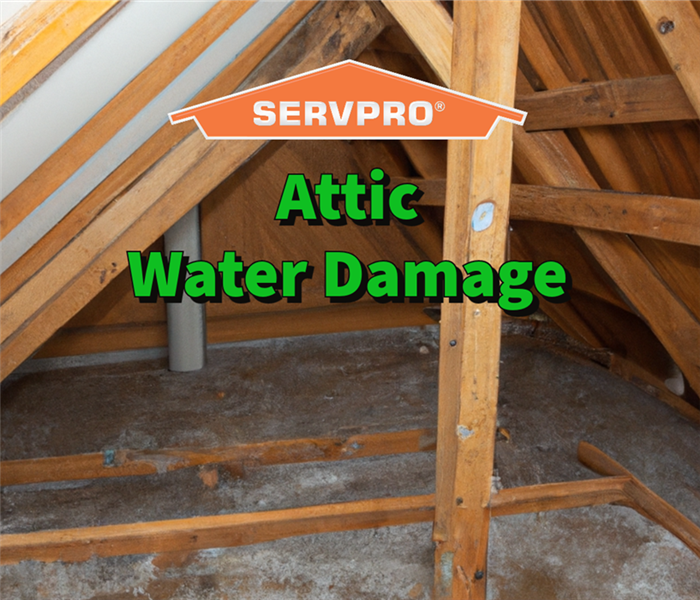 The professionals at SERVPRO offer tailored attic water damage solutions.
The professionals at SERVPRO offer tailored attic water damage solutions.
Attic water damage may go unnoticed for months without the occasional inspection.
Every homeowner dreads the thought of water damage—primarily when it occurs in a less-frequented area of the home, like the attic. Though often overlooked, the attic can be a primary source of significant issues if water damage occurs.
It’s not just about the potential harm; mold growth and structural damage can decrease your home’s value.
In the article, we’re diving deep into understanding the nuances of attic water damage. We’ll also relay how SERVPRO® expertly handled a particularly challenging case in Dayton, Ohio, earlier this year.
What is attic water damage?
Attic water damage is the deterioration that occurs when unwanted moisture or water infiltrates the attic space. This damage can range from staining of the ceiling to rotting of beams and mold growth. The reasons for water infiltration can vary, but the ramifications are equally dire if not addressed promptly.
How does attic water damage occur?
There are various routes for water to make its unwanted entry into the attic. Common causes include:
- Roof leaks: Damaged or missing shingles, faulty flashing, or a compromised underlayment can allow water to seep in.
- Blocked gutters: When gutters overflow, water can wick into the sheathing and flow into the attic.
- Condensation: A poorly ventilated attic can lead to moisture buildup, especially in colder months.
- Ice dams: In winter, ice can form at the edge of your roof, preventing melting snow from draining and causing it to seep into the attic.
- Faulty installations: Incorrectly installed or aged vents, skylights, and chimneys can be culprits, too.
What happens if water gets in your attic?
Once water enters your attic, it remains a complex water problem. If left untreated:
- Structural damage: Wood beams and support structures can weaken, leading to a compromised roof.
- Insulation damage: Wet insulation loses efficiency, leading to higher energy bills and comfort issues.
- Mold growth: Damp environments are breeding grounds for mold, which poses risks.
- Staining: Unsightly water stains can appear on the interior ceilings and walls.
Will wet attic insulation dry out?
Attic insulation cannot effectively dry on its own. While minor moisture may evaporate if given adequate ventilation and time, its efficacy drastically reduces once attic insulation becomes waterlogged. Mold growth becomes a concern, and the insulation often requires replacement.
SERVPRO to the rescue: A recent scenario
Earlier this year, our SERVPRO team received an urgent call from a Dayton, Ohio, homeowner who noticed a brownish water stain spreading on their bedroom ceiling. The team’s swift response uncovered significant attic water damage from a recent storm. At the root, the cause was damaged roof shingles.
The attic insulation was sodden, mold patches had started to form, and the wooden beams were damp. The homeowner was understandably distressed, but our SERVPRO professionals got to work immediately. With our advanced equipment, the team extracted the water, dried out the attic, replaced the compromised insulation, treated and eliminated the mold, and repaired the roof’s damaged section.
Tips to prevent attic water damage
- Regularly inspect your roof: Look for signs of wear and tear, such as missing or damaged shingles, which can be entry points for water.
- Clean gutters and downspouts: Ensure they’re debris-free to allow water to flow away from your home and not seep into the attic.
- Ensure proper attic ventilation: A well-ventilated attic can prevent condensation buildup and help avoid moisture damage.
- Install a vapor barrier: This measure can help keep moist air from your living spaces out of the attic.
- Check for ice dams post snowfall: After heavy snow, look for ice formations at the roof’s edge, which can trap water, forcing it under shingles and into the attic.
By following these tips, homeowners can effectively reduce the risk of attic water damage and safeguard the integrity of their property.
Why choose SERVPRO for attic water damage recovery?
You can always count on SERVPRO after your property suffers from attic water damage; here’s why:
- Quick response: At SERVPRO, we understand the importance of a rapid response. The faster we arrive, the less damage accrues.
- Experienced professionals: Our team has the skills and knowledge to handle any attic water damage situation.
- Advanced equipment: We invest in the latest technology to extract water-dry spaces and restore them to their pre-damage condition.
- Comprehensive service: We handle every step with precision, from initial assessment to final restoration.
- Customer satisfaction: Our commitment is to restore your property and ensure peace of mind.
Conclusion
Attic water damage, while often unnoticed until it becomes a significant issue, can lead to severe consequences for a homeowner. It is crucial to recognize the signs early, understand their implications, and know whom to call for help. Our Dayton case is a testament to SERVPRO’s expertise and dedication in handling such crises.
If you ever face attic water damage, remember that time is of the essence. The quicker you act, the lesser the damage, cost, and inconvenience. Trust SERVPRO to bring your home back to its best. After all, we’re the experts regarding water damage recovery.
The #1 Guide to Waterproofing: Stay Safe From Leaks!
7/31/2023 (Permalink)
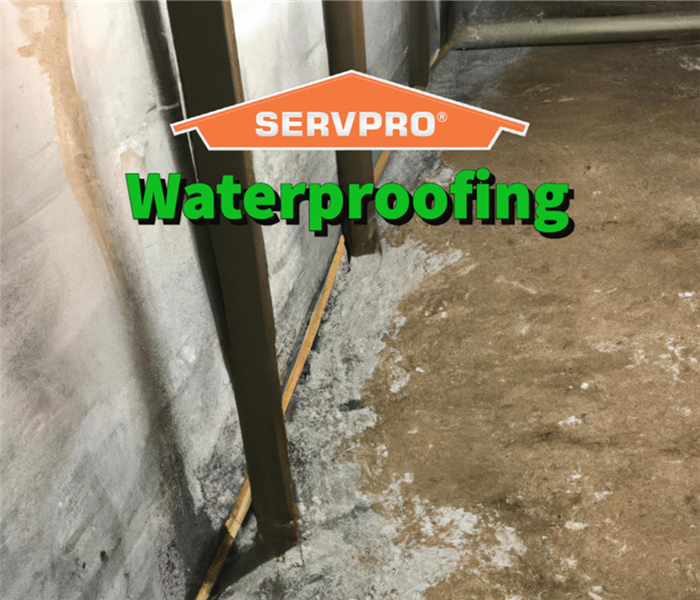 The professionals at SERVPRO are available 24/7 for emergency water damage services!
The professionals at SERVPRO are available 24/7 for emergency water damage services!
Waterproofing is the answer to preventing water damage.
Water damage is a significant concern for homeowners, and one of the areas most vulnerable to water infiltration is the basement or crawlspace. Unwanted moisture can lead to structural damage, mold growth, and other costly issues.
Waterproofing your basement or crawlspace protects your property from water damage and its associated consequences.
In this comprehensive guide, we'll explore the importance of waterproofing, the products used in the process, and why SERVPRO® is the ideal choice for water damage restoration.
What is waterproofing?
Waterproofing makes a structure impervious to water by applying specialized materials and techniques to prevent water intrusion. It involves sealing the foundation and walls to create a barrier against moisture, preventing it from entering the basement or crawlspace.
You create a dry and safe environment by waterproofing your basement or crawlspace, mitigating the risk of water damage to your property. Water intrusion can lead to various issues, such as structural damage, mold and mildew growth, musty odors, and compromised indoor air quality. You can avoid expensive repairs and hazards by addressing these concerns early on.
The importance of waterproofing
Water damage can occur for various reasons, including heavy rainfall, plumbing leaks, or inadequate drainage systems. Basements and crawlspaces are particularly susceptible to water intrusion because they are below ground level. Moisture can seep through cracks in the foundation, gaps in windows or doors, or even rise through the ground.
Without proper waterproofing, this excess moisture can lead to numerous problems. It can weaken the foundation, causing cracks and compromising the structural integrity of your property. The constant exposure to moisture can also create an ideal environment for mold growth, which can damage building materials and pose risks to occupants.
What techniques are used for waterproofing?
SERVPRO utilizes advanced products and techniques to ensure effective and long-lasting results when waterproofing your basement or crawlspace. Here are some of the critical methods and products used:
- Waterproofing membranes: high-quality waterproofing membranes act as a barrier against water penetration. These durable membranes are applied to the foundation walls, providing a protective shield that keeps water out.
- Sump pumps: these are essential for preventing water accumulation in basements or crawlspaces. They are designed to detect and remove excess water automatically, effectively preventing flooding and water damage.
- Drainage systems: installing an efficient drainage system diverts water away from the foundation, preventing it from pooling around your property. Drainage systems help maintain a dry basement or crawlspace and protect against water damage.
- Vapor barriers: these are plastic or foil sheets installed on walls and floors to prevent moisture from seeping into the basement or crawlspace. They help maintain a dry environment, reducing the risk of mold growth and other water-related issues.
SERVPRO's waterproofing services
SERVPRO offers comprehensive waterproofing services to help homeowners protect their properties from water damage. With our expertise and advanced techniques, SERVPRO ensures that your basement or crawlspace remains dry and resistant to water intrusion.
Our team of professionals begins by thoroughly assessing your property to identify potential vulnerabilities and areas prone to water seepage. We then employ high-quality waterproofing membranes, sump pumps, drainage systems, and vapor barriers to create a robust defense against water infiltration. SERVPRO guarantees effective and long-lasting waterproofing solutions using state-of-the-art equipment and proven methods.
With SERVPRO's waterproofing services, you can have peace of mind knowing that your property is safeguarded against the damaging effects of water, providing a secure and dry environment for your home.
What about water damage restoration?
When water damage does occur, it is essential to take immediate action to minimize the extent of the damage and prevent further complications. Here are some critical steps to follow when dealing with water damage:
- Ensure safety: before entering the affected area, assess potential hazards, such as electrical wires or structural damage. If necessary, turn off the power supply to the affected area.
- Contact professionals: as mentioned, SERVPRO is a reputable company specializing in water damage restoration. We have the expertise, equipment, and experience to handle the situation efficiently. Contact us as soon as possible to initiate the restoration process.
- Document the damage: take photographs or videos of the affected areas before cleaning or restoration begins. This documentation can be helpful for insurance claims and future reference.
- Remove standing water: if it is safe, you can start removing standing water using a wet/dry vacuum or buckets. However, if the water is contaminated or the area is extensive, it's best to leave this task to professionals.
- Dry out the area: proper drying is crucial to prevent mold growth and further damage. SERVPRO technicians will use specialized equipment like dehumidifiers and air movers to dry the affected area, including walls, floors, and furniture.
- Assess and remove damaged items: evaluate the extent of damage to belongings, furniture, and structural elements. Salvageable items should be moved to a dry area, while irreparably damaged items may need to be disposed of properly.
- Address mold growth: if mold has already started growing, it must be addressed promptly. Mold remediation is a specialized process that involves safely removing and preventing the further development of mold spores.
- Restore and repair: The repair process can begin once the area is thoroughly dried and cleaned. The repair process may involve repairing damaged structures, replacing flooring, repainting, and restoring the site to its pre-damaged condition.
SERVPRO professionals will work closely with you throughout the process, providing guidance and updates and helping with insurance claims if necessary. Remember, acting quickly and enlisting the help of professionals can significantly minimize the damage and ensure a smoother restoration process.
Wrapping up
Waterproofing your basement or crawlspace is an investment that pays off in the long run. It protects your property from water damage, prevents structural issues, and preserves indoor air quality. By choosing SERVPRO for water damage restoration, you benefit from their expertise, quick response, and comprehensive services.
Don't wait until it's too late—take proactive steps to safeguard your property today with SERVPRO and enjoy peace of mind knowing your home is protected from the devastating effects of water damage.
Contact us today for more information on protecting your property from water damage!
Foundation Leaks: 3 Powerful Tips to Protect Your Property
5/7/2023 (Permalink)
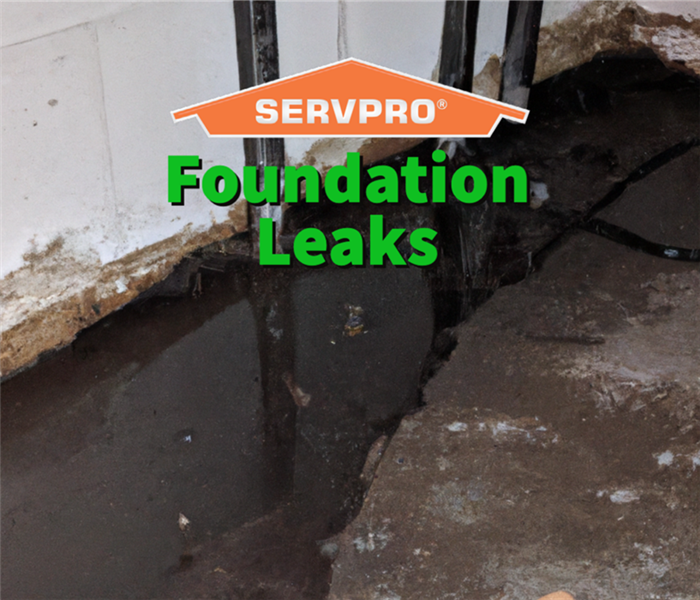 The professionals at SERVPRO are one call away from repairing and restoring your foundation leak!
The professionals at SERVPRO are one call away from repairing and restoring your foundation leak!
Be on the lookout for foundation leaks—they can cause significant water and property damage to your home.
As a trusted water damage restoration and remediation service provider, SERVPRO understands the importance of protecting your property from foundation leaks and water damage. Our experienced water damage professionals have the knowledge and expertise to help you prevent foundation leaks and mitigate any damage if one does occur.
This blog post outlines three helpful tips so that you can protect your property and avoid costly repairs. If you experience foundation leaks or other water damage, SERVPRO is here to help. Our team is available 24/7 to provide fast and reliable water damage restoration services so you can get back to normal as quickly as possible.
What are foundation leaks?
Foundation leaks occur when water seeps through cracks and other openings in a property's foundation. The foundation of a building is the structural base upon which the entire structure rests, so any damage to the foundation can be a severe problem.
Foundation leaks can occur for various reasons, including poor construction, soil settlement, and changes in temperature or moisture levels. When left untreated, foundation leaks can cause significant property damage like mold growth, weakened foundation walls, and structural damage. Therefore, it is essential to address foundation leaks as soon as they are detected to prevent further damage to your property.
3 prevention tips from SERVPRO experts
Protecting your property from foundation leaks and water damage is essential to maintaining the structural integrity of your building and preventing costly repairs. By taking a few simple steps, you can protect your property from the damaging effects of water and ensure that your facility remains safe and secure for years to come. Here are three of our favorite foundation leak-prevention tips:
Tip 1: Maintain Proper Drainage
Poor drainage in the adjacent yard is one of the leading causes of foundation leaks. When water is not correctly directed away from the structure, it can seep into your foundation, causing water damage. Therefore, it's crucial to ensure proper drainage around your property.
Start by inspecting the soil around your foundation. If it's sloping towards your property, water will collect and seep into your foundation. To fix this, regrade the soil to slope away from your property. Also, ensure that your gutters and downspouts are clear of debris and direct water at least three feet away from your foundation. Finally, if you notice standing water around your foundation, use a sump pump to remove it and prevent further damage.
Tip 2: Check Your Plumbing Regularly
Leaking pipes can cause water to collect and seep into your foundation, causing extensive property damage. Therefore, checking your plumbing for leaks or other issues is essential to prevent foundation leaks.
First, keep an eye on your water bill. If you notice a sudden increase in usage, it could indicate a hidden leak. Also, inspect your pipes and fixtures for signs of water damage or leaking, such as mold or dampness. If you suspect a plumbing issue, contact a licensed plumber to diagnose and repair the problem before it causes further damage.
Tip 3: Use Professional Waterproofing
Professional waterproofing is an effective way to prevent foundation leaks and protect your property from water damage. Waterproofing involves applying a sealant to your foundation walls, which prevents water from seeping in and causing damage.
Professional waterproofing is a complex process that a licensed contractor must perform. The contractor will inspect your foundation for any cracks or damage, then apply the sealant to protect your foundation from future water damage. This process can help prevent costly repairs and protect your property from foundation leaks for years.
Let SERVPRO combat your foundation leak.
Foundation leaks can be a severe problem for property owners, leading to costly repairs and extensive property damage if left untreated. However, by taking proactive measures and following the tips outlined in this blog post, you can help prevent foundation leaks from occurring in the first place.
If you experience a foundation leak or other water damage, SERVPRO is here to help. Our experienced professionals are available 24/7 to provide fast and reliable water damage restoration services so you can get back to normal as quickly as possible. We use advanced equipment and techniques to mitigate the damage and restore your property to its pre-damage condition.
Don't let a foundation leak or water damage threaten the safety and integrity of your property. Contact SERVPRO today and let us combat your foundation leak.
Window Leak Damage: 6 Signs of Potential Trouble
4/24/2023 (Permalink)
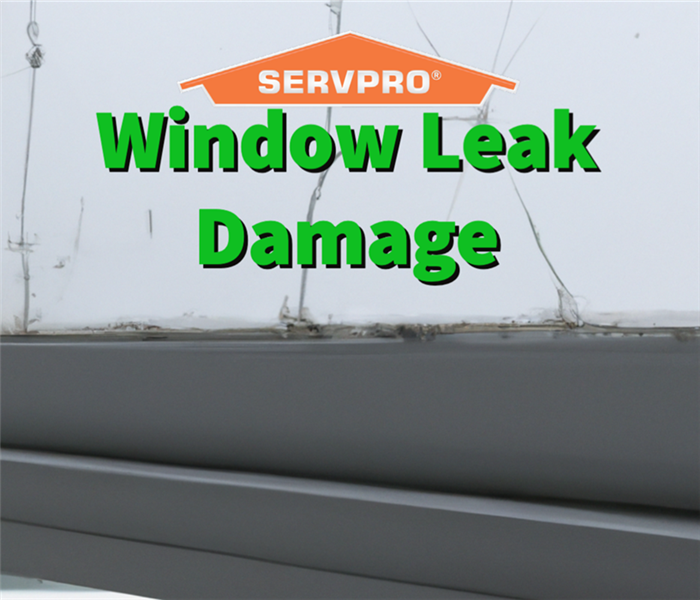 The professionals at SERVPRO are on-call ready to help combat damages caused by a window leak!
The professionals at SERVPRO are on-call ready to help combat damages caused by a window leak!
Don’t let window leak damage lead to mold growth!
Window leaks can be the source of significant water damage in any home. If not addressed quickly, they can cause severe and costly problems down the line. Knowing what causes window leaks and signs indicating potential damage is essential to protect your home from water-related issues.
This article will discuss the causes of window leak damage, provide insight into recognizing potential signs of trouble, and explain how professional water damage restoration services can help mitigate further destruction or repair existing harm.
Why does my window leak?
Window leaks are often caused by aging and wear and tear over time. As homes age, the windows are exposed to various weather conditions, such as harsh winds, heavy rain, and extreme temperature changes, leading to the deterioration of seals and caulking. These conditions can form gaps and cracks, allowing water to seep through and enter the home.
Moreover, poor installation is another leading cause of window leaks. If windows are not installed correctly, gaps or uneven spaces between the window frame and the wall may create pathways for water to infiltrate.
Additionally, condensation can also be a factor in window leaks. When warm and moist air comes in contact with a cold window, it can cause condensation, which may accumulate and result in water damage over time.
What damage can a leaking window cause?
A leaking window can cause a variety of damage to your home. The most immediately visible sign of window leak damage is discoloration or water stains on your walls or ceiling. However, the damage goes far beyond just the visible marks.
If left unaddressed, window leaks can lead to the growth of mold and mildew.
Window leaks can also damage your insulation and framing. Water seeping through compromised seals and caulking can saturate insulation, reducing its effectiveness and causing it to sag or deteriorate. Additionally, water damage can weaken and rot wood framing, creating structural issues that require professional repair.
Furthermore, if water can infiltrate your home through a window leak, it can even access your electrical system, resulting in shorts or outages and creating a dangerous fire risk.
Signs of potential trouble
Identifying window leaks as soon as possible is vital to prevent further damage. Here are some signs that may indicate potential trouble:
- Visible water damage: Noticeable water stains or discoloration on walls, ceilings, or floors near your windows may indicate the presence of a leak.
- Dripping water: If you see water dripping around your windows, it is a clear sign that water penetrates the seals or caulking and infiltrates your home.
- Condensation: If you observe persistent condensation on your windows, it may indicate a problem with the insulation or sealing, allowing outside moisture to enter the home.
- Mold or mildew growth: If you see mold or mildew development around your windows or in other parts of your home, this might suggest that water is getting inside and creating the perfect conditions for mold to thrive.
- Difficulty opening or closing windows: If your windows are becoming increasingly difficult to open or close or are not sealing correctly, it could be a sign of a potential leak.
- Drafts or air leaks: If you feel cold or hot drafts coming from around your windows or notice a noticeable increase in your heating or cooling bills, this could indicate a gap or crack, allowing air (and water) to penetrate the home.
Water damage restoration
Water damage restoration is a complex process that requires specialized equipment and expertise. If your home has suffered from water damage due to a leaking window, it is essential to engage the services of a professional restoration company as soon as possible.
The first step in the restoration process is to assess the extent of the damage. This assessment involves thoroughly examining the affected areas, including the walls, floors, ceilings, and any other sites that may have been exposed to water. Next, the restoration team will use advanced equipment, such as moisture meters and thermal imaging cameras, to determine the extent of the water damage and develop a plan of action.
Once the restoration team has assessed the damage, the next step is cleaning and drying. It involves removing standing water and extracting moisture from the affected areas using specialized equipment such as industrial dehumidifiers and air movers. The restoration team will also remove any damaged materials that are not salvageable, such as drywall, insulation, and flooring.
After the affected areas have been thoroughly dried, the restoration team will clean and disinfect the area to prevent mold and bacteria growth. This step involves using specialized cleaning agents designed to remove contaminants and sanitize the area.
Finally, the restoration team will begin the reconstruction process, which may involve repairing or replacing damaged materials such as drywall, insulation, and flooring. The aim is to restore your home to its pre-water damage condition and ensure the affected areas are safe and habitable.
Tips for Preventing Future Window Leak Issues
- Regular Inspection: It is essential to inspect your windows regularly for any signs of weathering or damage. This review should include checking the seals, caulking, and framing around the window for any cracks, gaps, or deterioration. An annual inspection can help catch any potential issues before they become significant problems.
- Proper Installation: A properly installed window can prevent leaks from occurring in the first place. Ensure that your windows are installed by a professional experienced in window installation. Improper installation can lead to gaps and cracks in the sealing, allowing water to penetrate your home.
- Keep Gutters and Downspouts Clean: The gutters and downspouts around your home help to direct water away from your home’s foundation. Keeping these clean and debris-free prevents water from backing up and overflowing around your windows.
- Maintain Proper Drainage: Proper drainage around your home is essential to preventing water damage. Ensure your yard slopes away from your home to ensure proper drainage. Additionally, consider installing a French drain or other drainage systems if you live in an area with heavy rainfall or poor soil drainage.
- Install Window Well Covers: If you have below-grade windows, consider installing window covers to prevent water from entering the wells and potentially causing leaks into your home. These covers can also help to keep debris and leaves out of the wells.
- Repair Leaks Promptly: If you notice a leak around your window, address it promptly. Ignoring a leak can lead to further damage to your home and potential health hazards from mold growth. Instead, contact a professional to have the problem assessed and repaired as soon as possible.
Let SERVPRO help you recover from water damage!
Window leaks can cause a great deal of water damage in your home, so it’s crucial to identify and address any issues as soon as possible. Our tips for preventing future window leak damage include regular inspection, proper installation, keeping gutters and downspouts clean, maintaining adequate drainage around the house, installing window well covers, and repairing leaks promptly.
If you have experienced water damage due to a window leak or other issue, SERVPRO is here to help! We offer professional restoration services that will help get your home back into shape quickly and safely. Contact us today to learn more about our services.
Wet Drywall: The 3 Most Common Signs
8/22/2022 (Permalink)
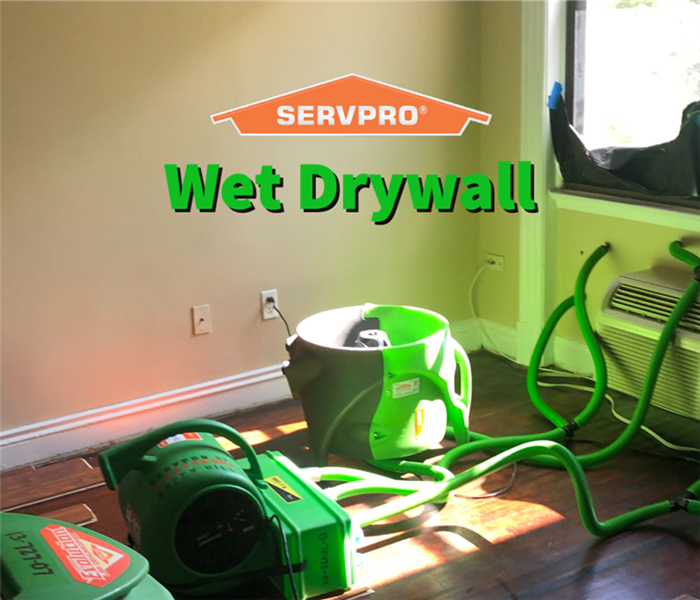 The professionals at SERVPRO are available 24/7 to combat water damage!
The professionals at SERVPRO are available 24/7 to combat water damage!
The professionals at SERVPRO use moisture meters to detect wet drywall.
SERVPRO of East Dayton/Beavercreek has served those living in the Greater Dayton area for over 25 years. As experts in water damage restoration, we can help you identify wet drywall and take the necessary steps to prevent further damage.
We know firsthand that wet drywall can be detrimental to the structure of your building. Therefore, it is essential to take wet drywall seriously and to call a water damage professional as soon as possible.
Several signs indicate wet drywall, and in the following blog post, we will be going over the three main indications in detail. By the end, we hope you know how to identify wet drywall better and can avoid any future water damage in your home.
What are the causes of wet drywall?
Before we dive into the signs of wet drywall, let's briefly go over some of the common causes of wet drywall. The most common cause of wet drywall is the result of a pipe burst. Your home consists of pipes responsible for bringing fresh water into your home and removing wastewater. If one of these pipes bursts, it can cause wet drywall.
Another common cause of wet drywall is a roof leak. Your roof is constantly exposed to the elements and may develop cracks or holes over time. When your roof is not properly maintained, water can enter your home through these cracks and holes and cause wet drywall.
The last common cause of wet drywall is due to appliance leaks. Many appliances in your home, such as your washing machine, dishwasher, and water heater, use water. If one of these appliances leaks, it can cause wet drywall.
Three signs of wet drywall
Now that we've gone over some of the common causes of wet drywall, let's dive into the three main signs of wet drywall:
- Water stains
- Warping
- Mold growth
Water stains
The first sign of wet drywall is water stains. Water stains can be hard to miss and are often the first sign that something is wrong. So if you see water stains on your drywall, it's a good indication that wet drywall is present.
Warping
The second sign of wet drywall is warping. Warped drywall is another easy-to-spot sign of wet drywall. Warped dry will no longer appear as flat because water has been absorbed.
Mold growth
The third and final sign of wet drywall is mold growth. Mold is a fungus that thrives in damp environments. So if you see mold growing on your drywall, it's a good indication that wet drywall is present.
How to prevent wet drywall from happening in your home
Water damage is one of the most common causes of wet drywall. If you want to prevent wet drywall from happening in your home, there are several things you can do:
The first thing you can do is properly maintain your roof. Check for any cracks or holes and repair them as soon as possible. Water can enter your home and cause wet drywall if you don't maintain your roof.
The second thing you can do is properly maintain your appliances. Check for any leaks and fix them as soon as possible. If you don't maintain your appliances, they can leak and cause wet drywall.
The last thing you can do is install a water alarm. A water alarm will notify you if there is any water in your home, which will help you detect wet drywall before it becomes too severe.
How can the professionals at SERVPRO of East Dayton/Beavercreek help combat wet drywall?
Today we went over the three main signs of wet drywall and the common causes. We also discussed some tips on preventing wet drywall from happening in your home because prevention is critical. However, wet drywall can still occur even if you take all the necessary precautions. If wet drywall does happen in your home, the professionals at SERVPRO of East Dayton/Beavercreek are here to help!
The professionals at SERVPRO of East Dayton/Beavercreek are all IICRC certified and have the knowledge, experience, and equipment to correctly identify wet drywall and take the necessary steps to prevent it from causing further damage.
Please get in touch with us anytime for any questions or information on how we can combat water damage in your home or business!
Hardwood Water Damage: The #1 Guide For Restoration
8/7/2022 (Permalink)
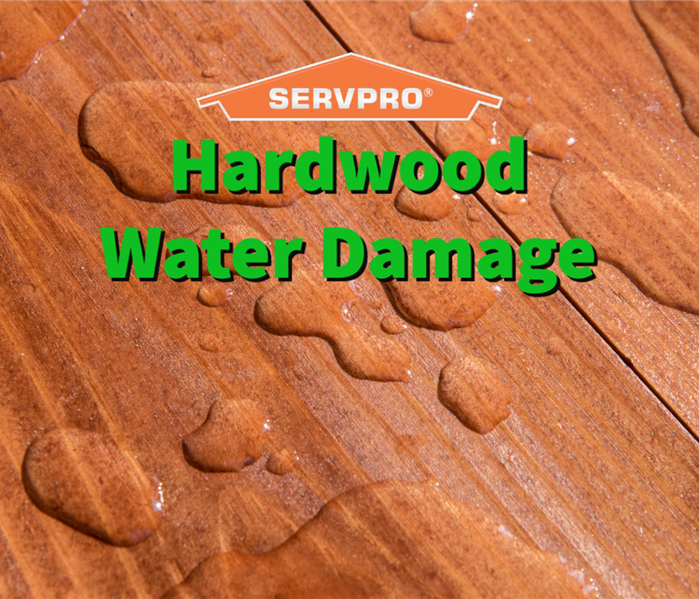 The professionals at SERVPRO can restore your water-damaged hardwood floors!
The professionals at SERVPRO can restore your water-damaged hardwood floors!
The professionals at SERVPRO of East Dayton/Beavercreek can save your hardwood floors from water damage!
Water damage is a severe problem that can affect any home, and one of the worst items to get wet are hardwood floors. Hardwood floors are not only expensive to replace, but they are also difficult to repair. The best way to avoid having to replace your hardwood floors is to take immediate action when water damage occurs.
This comprehensive guide will show you everything you need to know about restoring your hardwood flooring after water damage. The professionals at SERVPRO of East Dayton/Beavercreek are your one-stop shop for water damage restoration.
What is hardwood water damage?
Hardwood water damage is damage that occurs when water seeps into the cracks and joints of your hardwood floors. Hardwood water damage can happen from a number of sources, including leaks, spills, and floods. When water damage occurs, it is essential to take action immediately. The longer you wait, the more damage will occur. The following signs are indications that your hardwood floors have been affected by water damage:
- Warped or buckled flooring
- Gapping between floorboards
- Peeling or bubbling paint or varnish
- Mildew or mold growth
- Odors such as mustiness or sewage
What to do if you experience hardwood water damage?
The first thing you need to do when you experience hardwood water damage is to assess the damage. You will want to look at the type of water infiltration, the type of wood flooring, and the severity of the damage. Once you have assessed the damage, you must contact a reliable water restoration company and provide them with the gathered information.
What to expect from the restoration process
When contacting a team of water restoration professionals, they will work quickly to create a plan of action. The goal is to restore your hardwood floors to their pre-damaged state. This process usually takes a few days to a week to complete.
During the restoration process, the team of professionals will:
- Remove all water from the flooring
- Remove all damaged floorboards
- Sand and refinish the entire floor
- Clean and disinfect the area
Once the restoration is complete, your hardwood floors will look as good as new!
Preventing hardwood water damage in the future
One of the best ways to prevent permanent hardwood water damage is to take immediate action when water damage occurs. The longer you wait, the more damage will occur. In addition, you can take steps to prevent water damage from happening in the first place.
Some steps you can take to prevent water damage include:
- Installing a waterproof membrane under your flooring
- Ensuring your gutters are clear and draining properly
- Checking your roof for leaks regularly
- Ensuring your appliances are functioning properly
These are just a few of the measures you can take to help prevent water damage in your home. Following these precautions can help ensure your floors stay safe from moisture and water infiltration.
How SERVPRO of East Dayton/Beavercreek helps with hardwood water damage?
SERVPRO of East Dayton/Beavercreek is a reliable and experienced water restoration company that can help you restore your hardwood floors after water damage has occurred. We have the knowledge and resources to get the job done quickly and efficiently.
When you choose to work with our team of IICRC water damage restorers, you can expect the following:
- A quick response time
- A thorough assessment of the damage
- A detailed plan of action
- A complete restoration of your flooring
If you are experiencing hardwood water damage, please get in touch with us immediately. We are available 24/7 to start the restoration process and help you get your beautiful floors back to normal.
The Top 3 Crawl Space Water Damage Causes: What You Need to Know
7/11/2022 (Permalink)
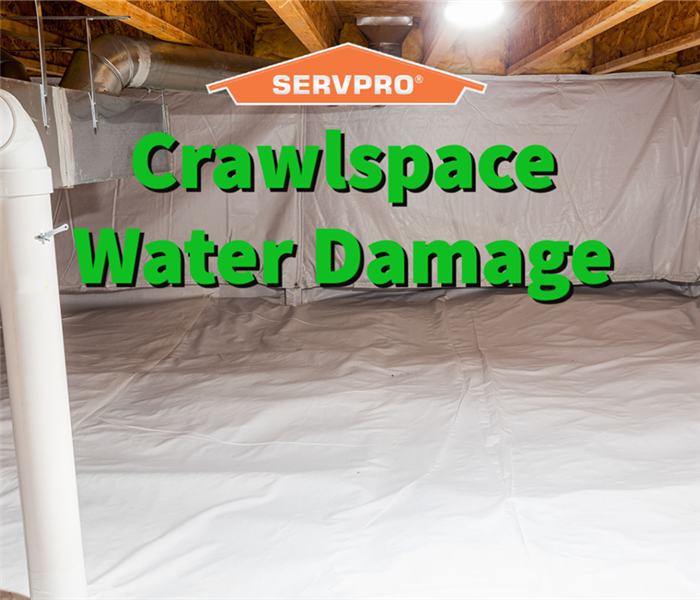 SERVPRO professionals can help remove and prevent crawl space water damage!
SERVPRO professionals can help remove and prevent crawl space water damage!
Water damage can be a massive headache, and it's even worse when the damage is in your crawl space.
The professionals at SERVPRO of East Dayton/Beavercreek have seen it all when it comes to water damage, and we know that water in your crawl space can come from many different sources.
This blog post will go over the top three causes of crawl space water damage and what you can do to prevent it. We put this blog post together because we want to help you keep your home in tip-top shape and avoid water damage before it starts.
What is crawl space water damage?
Crawl space water damage occurs when water seeps into your crawl space. Crawl space water damage can be minor, such as moisture on the floors or walls, or it can be significant, such as flooding. Crawl space water damage is often hard to spot because it's out of sight and out of mind. Hence why it's essential to be aware of the signs of crawl space water damage, which we will review later in this blog post.
The three leading causes of crawl space water damage
Now that we understand crawl space water damage let's look at the three leading causes.
1) Faulty roof
One of the most common causes of crawl space water damage is a faulty roof. If your roof leaks, it's only a matter of time before the water seeps into your crawl space. A leaky roof is often caused by missing or damaged shingles, but a faulty gutter system can also cause it.
If you suspect that your roof is leaking, it's essential to have it checked out by a professional as soon as possible. The sooner you catch the problem, the less damage there will be.
2) Plumbing leak
Another common cause of crawl space water damage is a plumbing leak. If there is a leak in your plumbing, the water will eventually make its way into your crawl space. A plumbing leak can result from many different things, such as a broken pipe or a faulty appliance.
If you suspect a plumbing leak, it's essential to have it fixed as soon as possible. The longer the leak goes unrepaired, the more damage it will cause.
3) Groundwater seepage
Ground seepage is the third and final leading cause of crawl space water damage. Groundwater seepage occurs when water from the ground seeps into your crawl space caused by a high water table or poor drainage around your foundation.
If you suspect that you have groundwater seepage, it's essential to have it checked out by a professional as soon as possible. The sooner you catch the problem, the less damage there will be.
What are the signs of crawl space water damage?
Now that we have gone over the three leading causes of crawl space water damage, let's look at the signs. The sooner you catch the signs of crawl space water damage, the sooner you can take corrective action and prevent further damage.
Some of the most common signs of crawl space water damage include:
- Water stains on the walls or ceiling
- Mold or mildew growth
- Musty odors
- Damp floors
- Peeling paint
- Rusting metal
If you notice any of these signs in your crawl space, it's essential to have it checked out by a professional as soon as possible. The sooner you catch the problem, the less damage there will be.
Preventing crawl space water damage
The best way to deal with crawl space water damage is to prevent it from happening in the first place. Here are some tips on how you can avoid crawl space water damage:
- Inspect your roof regularly and have any leaks fixed as soon as possible.
- Check your plumbing regularly for leaks and correct them as quickly as possible.
- Make sure your gutters are clean and in good working condition.
- Inspect your foundation periodically and seal any cracks or gaps.
- Improve the drainage around your foundation.
- Install a sump pump in your crawl space.
If you follow these tips, you can help prevent crawl space water damage.
What to do if you have crawl space water damage
If you have crawl space water damage, it's essential to take corrective action as soon as possible. The longer you wait, the more damage the water will cause. Here are some tips on what you can do if you have crawl space water damage:
- Call a professional. Crawl space water damage is not something you should try to fix on your own. Calling a professional with the knowledge and experience to deal with the problem correctly is essential.
- Remove any standing water. If there is any standing water in your crawl space, it's essential to remove it as soon as possible. The longer the water stands, the more damage it will cause.
- Dry out the area. Once all the standing water is removed, it's essential to dry out the area. Fans, dehumidifiers, or a wet/dry vacuum are the best pieces of restoration technology to dry a crawlspace.
- Remove any damaged materials. Once the area is dry, you can remove any damaged materials, including insulation, flooring, walls, etc.
- Clean and disinfect the area. Once the damaged materials have been removed, cleaning and disinfecting the area is essential to help prevent mold and mildew growth.
- Repair any damage. Once the area is clean and dry, you can start repairing any damage caused by the water, including fixing leaks, sealing cracks, etc.
If you follow these tips, you can help minimize the damage caused by crawl space water damage.
The professionals at SERVPRO of East Dayton/Beavercreek can restore your crawl space water damage.
The professionals at SERVPRO of East Dayton/Beavercreek have mitigated hundreds of homes and businesses that have had crawl space water damage. We understand the importance of acting quickly and will work quickly to restore your home or business to its pre-water damage condition.
We have the knowledge and experience to deal with all types of water damage, no matter how big or small. We use state-of-the-art equipment and techniques to dry out your home or business and prevent further damage.
Don't hesitate to contact us if you have crawl space water damage. We are available 24/7/365 and will respond to your call immediately.
Water Damaged Carpet: 3 Indications Where Replacement is Necessary
5/2/2022 (Permalink)
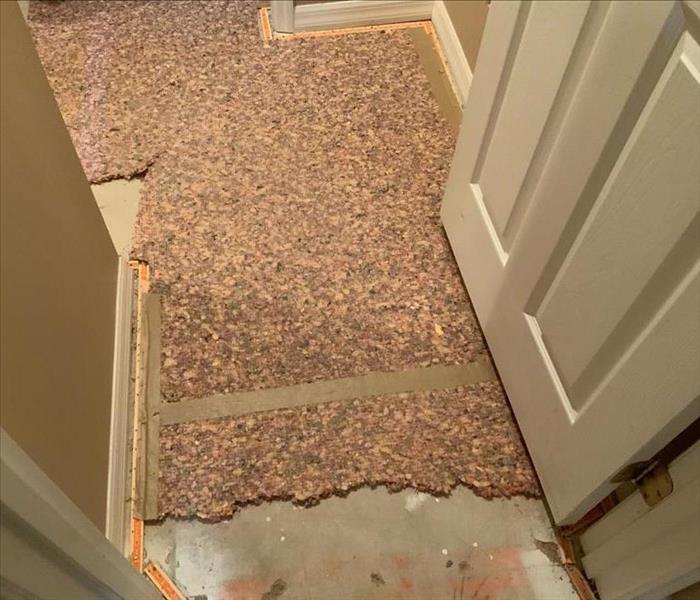 Contact the professionals at SERVPRO for fast responding water damage services!
Contact the professionals at SERVPRO for fast responding water damage services!
Water can cause severe damage to carpeting.
It is proven that water damage can lead to mold and other bacteria growth, but it can also damage furniture, flooring, and other belongings. One of the most commonly damaged items from water damage is the carpet. In some cases, water restorers can repair water-damaged carpets, but other times, they will need replacing.
The professionals at SERVPRO of East Dayton/Beavercreek are happy to share information gathered through their years of experience and training. Therefore, in the following blog post, we will share three indications that your water-damaged carpet may need replacing.
What is water damage?
Before discussing when a water-damaged carpet may need replacing, it is essential to understand what constitutes water damage and how it can occur. Water damage can happen in several different ways, including:
- Heavy rain or natural disasters
- Plumbing issues, such as loose pipes or clogged drains
- Malfunctioning appliances
- Sewage backup or septic tank problems
The severity of water damage depends on the amount and type of water, how long the carpet sits in water, and other factors. Therefore, it is essential to take action as soon as possible to prevent further damage from occurring.
The three indications where replacement is necessary
In the restoration industry, there are three classes of water damage (I, II, III), and two of these water damage classes require replacing.
1) The first indication that your water-damaged carpet requires replacing is if it has been affected by class II water damage. Class II refers to water containing some contaminants that saturate the carpet, making it difficult to dry and repair. If your carpet has been affected by class II water damage, it will likely need replacing.
2) The second indication that carpet with water damage may need replacing is if the damage has reached class III, also known as sewage water. Sewage water is classified as category III water damage and can cause severe problems if not properly cleaned and disinfected.
3) The last and final indication that carpeting with water damage may need replacing is if there is mold growth on or under the carpet. Water sitting for an extended period can cause mold to grow, and if this is the case, the carpet will need replacing.
When does water-damaged carpeting not have to be replaced?
Above, we discussed class II and III water damage and how they may require the replacement of your water-damaged carpet. So when does water-damaged carpeting not have to be replaced?
The answer is that it depends on the severity of the damage. For example, Class I water damage is damage caused by clean water and typically causes minimal problems. Class, I water damage is often easily repaired unless it is allowed to sit for an extended period.
Will water-damaged carpet dry on its own?
When there is water damage to the carpet, it will not dry on its own and must be cleaned and dried as soon as possible to prevent further damage.
Hiring professional water restoration services is the proper way to dry water-damaged carpeting. The appropriate team of professionals will have the tools and experience necessary to clean and restore your water-damaged carpet properly.
Wrapping up
We hope that this post has helped you understand the three main indications that water-damaged carpeting requires replacing. If your carpet has been affected by water damage, it is essential to seek water restoration services as soon as possible. To learn more about water-damaged carpets and how they can be restored or replaced, contact the experts at SERVPRO of East Dayton/Beavercreek.
Our team of professionals has gone through extensive training by the IICRC and has years of experience in restoring water-damaged carpets. We are here to help, so do not hesitate to contact us today for more information!
What to Do If a Water Heater Bursts: Causes and Prevention Tips
4/18/2022 (Permalink)
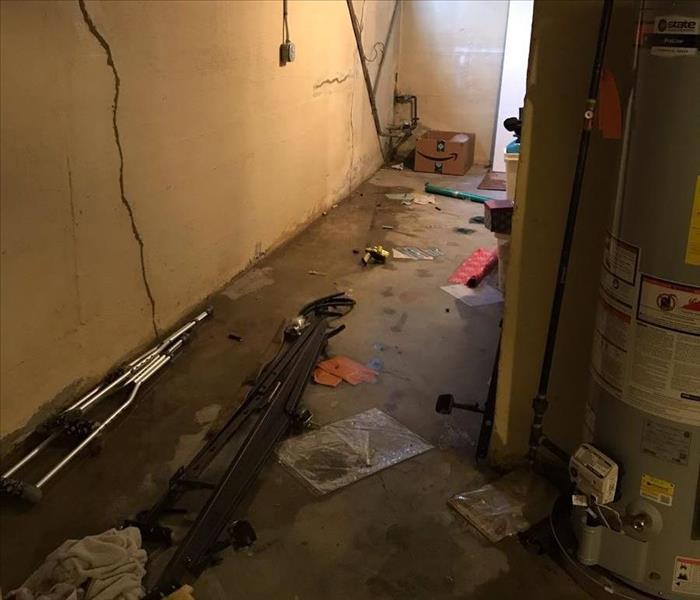 Contact the professionals at SERVPRO for the fastest water damage response times in Ohio!
Contact the professionals at SERVPRO for the fastest water damage response times in Ohio!
Did you know that about 10% of our water damage calls are related to burst water heaters?
All property owners know that a water heater is a costly investment, and it's essential to take care of it to help it last as long as possible. The average lifespan of a hot water heater depends on if it is gas or electric.
An electric hot water heater will last anywhere from ten to fifteen years, while a gas hot water heater will last roughly eight to twelve years. Of course, with proper maintenance, your water heater can last even longer. However, sometimes water heaters just break down and need to be replaced.
One of the most unfortunate things to occur in a home is when a water heaters bursts, which can happen at any time and will likely cause severe water damage to your home.
If your water heater bursts, you may not know what to do, but don't worry! This blog post will go over the causes of water heater bursts and prevention tips to help keep your home safe.
3 Causes of a burst hot water heater
There are many different reasons that a water heater can burst, but here are three of the most common causes:
- Sediment build-up: Sediment build-up can cause a water heater to burst because it puts stress on the tank. As water is heated and then cooled, minerals such as calcium and magnesium can settle at the bottom of the tank. Over time, this sediment build-up can cause the water heater tank to crack or even burst.
- Corrosion: Corrosion can cause a water heater to burst because it weakens the tank. Over time, the metal in the tank will start to corrode due to exposure to water and oxygen. Corrosion can cause the tank to become structurally weak and eventually lead to a rupture.
- Excess internal pressure: Too much internal pressure can cause a water heater to burst. Excess pressure can happen when the temperature and pressure relief valve (T&P valve) is not working correctly or the tank is too full. When there is too much pressure in the tank, it can cause the tank to rupture.
3 Prevention tips
Now that we know some of the causes of a water heater bursting, let's go over some prevention tips:
- Drain the tank regularly: Draining the tank helps to remove sediment build-up. We recommend draining your water heater tank at least once a year. You can do this by attaching a hose to the drain valve and draining the water into a bucket or drain.
- Check the T&P valve: The T&P valve is a safety feature that releases pressure and prevents the tank from bursting. It's important to check this valve regularly to ensure it is working correctly. You can check the valve by lifting up the handle to see if water comes out. If water does not come out, the valve needs to be replaced.
- Don't overfill the tank: Be sure not to overfill the tank beyond the manufacturer's recommended level; it could cause excess pressure and make the tank more likely to burst if you do.
What to do if your water heater bursts?
If your water heater bursts, it's essential to know what to do. The following is what the professionals at SERVPRO of East Dayton/Beavercreek recommend:
Shut off the water: The first thing you need to do is shut off the water to the tank. Shutting off the water will help to prevent any further water damage.
Turn off the power: If the water heater is electric, be sure to turn off the power at the breaker box. If it is gas, then turn off the gas supply.
Drain the tank: Once the water and power are shut off, you can start to drain the tank. Attach a hose to the drain valve and open it up. Drain the water into a bucket or drain.
Call a water restoration company: Once the water is drained, it's time to call a water restoration company for help. The right company will be able to clean and repair any water damage.
Final thoughts
We hope you found this blog post on water heaters helpful. If you have any questions or need water damage restoration services, please contact us immediately!
The professionals at SERVPRO of East Dayton/Beavercreek are highly trained and certified by the IICRC in water damage restoration. We have the experience and knowledge to get your home or business back to pre-water damage condition. We understand that water damage can be stressful; that's why we will work with you to make the process as smooth as possible.
Skylight Leak: 5 Great Tips To Prevent A Skylight From Leaking
11/1/2021 (Permalink)
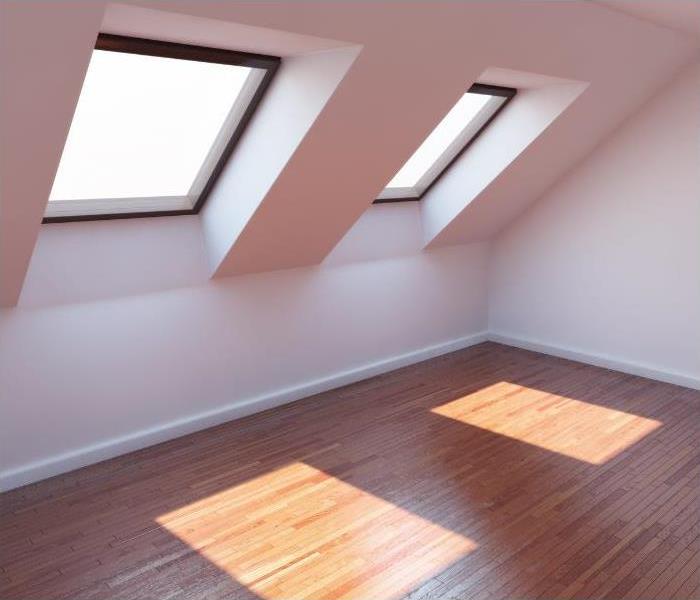 Contact the professionals at SERVPRO for Skylight installation and leak repair!
Contact the professionals at SERVPRO for Skylight installation and leak repair!
Skylight leaks are one of the most common causes of water damage in many Dayton homes.
We are sure you've heard that a leaky skylight can cause significant water damage to your ceiling and other parts of the house, but did you know it could also lead to mold growth? However, there are some ways to prevent these issues from happening!
For a skylight to leak, something has either gone wrong with the installation or maintenance. In some cases, an improperly installed flashing is the culprit; in others, improper caulking may be at fault. Skilled professionals can identify and fix these problems before they cause leaks.
In the following blog post, we will go over ways that the professionals at SERVPRO suggest you can prevent a skylight from leaking. Our crews have had to mitigate and restore hundreds of skylight leaks, so we are glad to share this information with you.
Signs of a skylight leak
It's important to know the signs of a skylight leak. Keep an eye out for dark spots on the ceiling below your skylights, such as water stains or mold. You may also be able to hear signs of a leak, such as dripping or puddling.
If you notice any condensation or leaks around your skylight, it's best to call a professional restoration company immediately and get it fixed before the water damage becomes extensive.
5 great tips in preventing a skylight leak.
Tip 1: The first tip is to ensure that your flashing was installed properly when you had your skylight installed. Skylight flashing is the material that surrounds the base of your skylight. It's designed to keep rain and snow out, so water can't seep in and cause severe damage.
Tip 2: The second tip is to ensure that your skylight has the proper ventilation. Water vapor can build up around your skylight during the colder months, so it is important to add insulation around the skylight's framing.
Tip 3: The third tip is to reapply caulking around your skylight if it's beginning to peel away from its frame. Caulking is a great coating to prevent water from seeping in, but it will only work if applied correctly. In addition, you will want to seal off any openings at least once a year for normal wear and tear.
Tip 4: The fourth tip is to clear out any gathered leaves around the skylight and to install a screen if not present. A screen will help prevent dirt, leaves, or any other materials from entering the home, and removing excess debris will prevent water from pooling.
Tip 5: The fifth and final tip is to inspect the skylights regularly.
If you do these things and prevent a skylight leak from occurring, you will save your skylights and money on repairs and materials.
Call SERVPRO today for expert advice and service.
The professionals at SERVPRO understand that the best way to avoid water damage from occurring is understanding how it begins in the first place. With that being said, we hope that you found this post helpful in preventing a skylight from leaking. To learn more about our services and other ways to prevent water damage, contact SERVPRO of East Dayton/Beavercreek today! We can help you remove any amount of standing water and stop any mold growth before it starts!
SERVPRO of East Dayton/Beavercreek is here for you 24 hours a day, 7 days a week! Additionally, our technicians are certified by the Institute of Inspection, Cleaning, and Restoration Certification, also known as the IICRC, to perform water restoration in your home or commercial property.
AC Water Leak: What to Do When Your Air Conditioner is Leaking Water
9/20/2021 (Permalink)
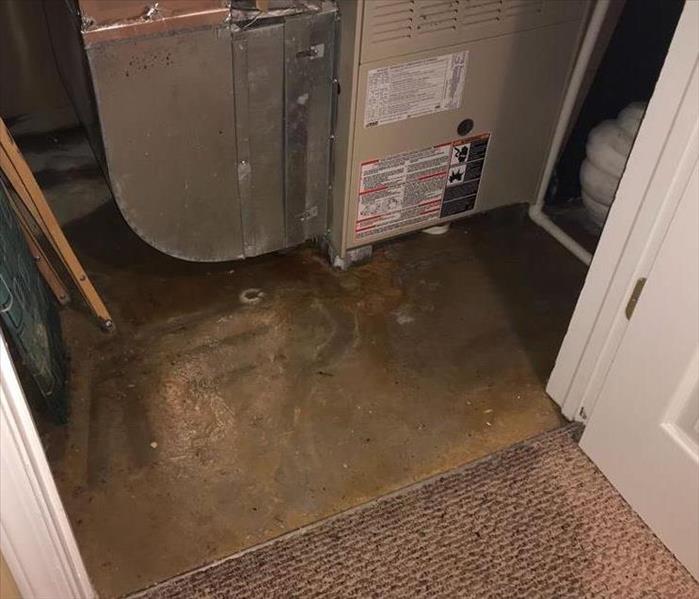 Contact the professionals at SERVPRO when you have water damage from a leaking air conditioning unit!
Contact the professionals at SERVPRO when you have water damage from a leaking air conditioning unit!
An air conditioner leak can be a serious problem because it means that your ac unit is no longer working properly and can result in major damages to your home.
The professionals at SERVPRO of East Dayton/Beavercreek have seen all types of property water damage caused by numerous sources. However, one of the most common water damage calls we receive is from an air conditioner leaking water.
If you're reading this blog post, chances are your ac unit is currently leaking water, and you need help navigating the situation. If this is the case, you need to address the water damage issue immediately before mold starts to grow!
Early signs of an air conditioner leak
Most commonly, property owners do not notice an ac leak until there is apparent water damage. However, before water damage occurs, you may be able to catch the leak early on by paying attention to your energy bills because a leaking ac unit will likely lead to high energy bills. Another early indication of an air conditioner leak will be the visibility of mold growth throughout a property. If you notice either one of these two signs, then you should contact HVAC professionals to come and inspect your property's air conditioning unit for leaks.
Why does an air conditioner leak?
A property may have an air conditioner leak because of either ac system malfunction or an ac unit installation failure.
Common air condition malfunctions include:
- A clogged condensate drain line: A clogged condensate drain line is the most common reason for an ac leak. A clogged condensate drain line can occur when dust, dirt, or mold causes a clog. The only way to fix a clogged condensate drain line will be to unclog it with a special vacuum.
- A damaged drain pan: After a certain amount of time, an air conditioner's drain pan will damage and no longer catch water. The best way to fix a damaged air conditioner drain pan will be to replace it with a new one.
- A broken condensate pump: A condensate pump is a type of pump that pumps water from air conditioning units to the outside. The best way to fix a broken condensate pump will be to replace it with a new one.
- A dirty air filter: Dirty air filters will prevent airflow to the air conditioner's evaporator coil. After some time, the evaporator coil will freeze and unfreeze and cause excess water to leak from the ac unit. Regularly changing the air filter is the best way to prevent an evaporator coil from freezing over.
What to do when the air conditioner is leaking water?
You will need to act fast at the first sign of an air conditioner leaking water to prevent severe damages from occurring. The professionals at SERVPRO of East Dayton/Beavercreek put together the following mitigation steps to reduce the property damages.
Steps to mitigate an air conditioner leak
- Turn off the thermostat to prevent further water from leaking
- Contact your property insurance company to start a claim
- Contact a reliable HVAC company for ac repairs
- Contact a reliable water restoration to clean up and restore the damages
Wrapping up
We hope you enjoyed learning about the most common reasons why an air conditioner leaks water and the steps to mitigate the damages.
Many property owners throughout the Dayton metropolitan area have chosen to rely on the professionals at SERVPRO of East Dayton/ Beavercreek for water damage restoration services. SERVPRO of East Dayton/ Beavercreek is the first choice because we are a locally-owned company that has been dedicated to helping restore homes and businesses to their pre-water damage conditions since 1967.
When you choose to contact our professionals for water damage services, we will bring years of experience along with certifications to ensure that your water damage is mitigated quickly and professionally.
Please contact us today for more information on our water damage services or to schedule an appointment.
Fireplace Standing Water: The Top 3 Causes For a Fireplace Leak
9/6/2021 (Permalink)
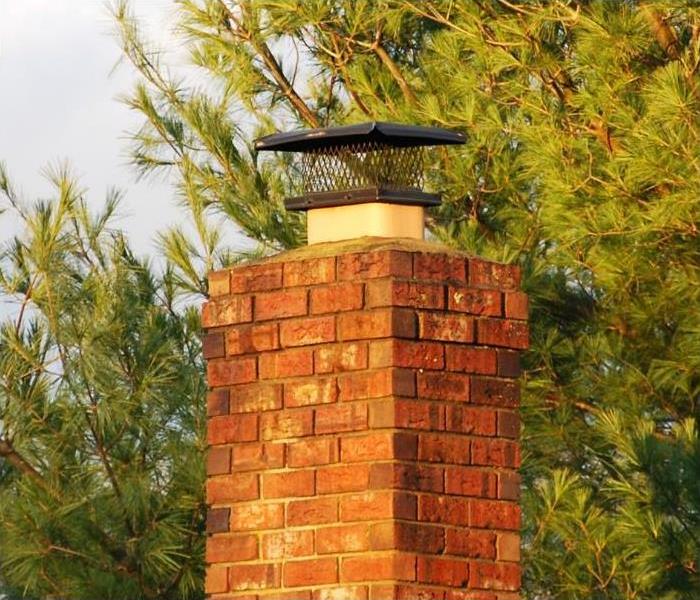 Contact the water damage professionals at SERVPRO when you find standing water in the fireplace!
Contact the water damage professionals at SERVPRO when you find standing water in the fireplace!
A Dayton homeowner may be confused why there is standing water in their fireplace.
Consider yourself lucky if you are a homeowner that has never found standing water at the bottom of the fireplace. There are many reasons why a fireplace may have standing water, but the most common is a fireplace leak in the chimney. This blog post will discuss three of the top causes for a chimney leak, as well as what you should do if you find standing water in the fireplace.
Signs of a fireplace leak
A homeowner will likely be left with water damage after a rainstorm passes when there is a chimney leak. A clear indication of a chimney leak will be standing water at the bottom of the fireplace. A fireplace leak left to sit for a prolonged period can start affecting the walls and ceilings around the fireplace with mold damage.
3 Common causes of fireplace leaks
- Cracked chimney crown: A chimney crown is the top part of the chimney located directly above the fireplace. If there is standing water in your fireplace, it may be due to a cracked crown or an insufficient amount of mortar.
- Damaged fireplace flashing: Fireplace flashing is a thin steel or aluminum sheet used to seal the fireplace from rainwater. Damaged flashing can cause standing water in a fireplace and high energy bills due to the accessibility of outdoor elements.
- A damaged or missing chimney cap: A chimney cap is a fireplace accessory used to help prevent water leaks and animals from clogging the fireplace flue. If you are experiencing standing water in your fireplace, it might indicate that your chimney cap is damaged or missing.
A recent fireplace leak service call
A few months back, the professionals at SERVPRO of East Dayton/Beavercreek received a call from a homeowner who found standing water inside and around their fireplace. The homeowners knew about our water damage services because we had serviced their home the previous year after a dishwasher leak.
For this particular water damage call, we knew that we had to go up on the roof and inspect the chimney to determine the cause of the fireplace standing water. After about an hour of inspecting the chimney, we found that the cement chimney crown had a crack. The chimney crown crack had allowed water into the flue lining and entered the chimney.
The homeowners were happy to find out that there was no mold growth inside the chimney flue, and we were able to professionally seal the cracks rather than having to replace the chimney crown.
After a few days, we were able to remove all standing water in the fireplace without severe demolition, and the homeowner was able to start using their chimney "Like it never even happened."
What to do when there is standing water in the fireplace?
It is essential to contact a water damage professional at the first sign of standing water in a fireplace. Water damage professionals will commonly use thermal moisture imaging cameras to easily determine the standing water location and severity of the damage, even when it is hidden from plain sight.
Once they can locate the location and the severity of the damage, they will design a unique drying plan tailored to the damaged property.
Wrapping up
As you have learned, standing water in the fireplace can cause major structural damage, especially if some cracks or holes allow for more water to enter into the flue lining and then inside the chimney structure itself. If you find standing water in the fireplace, you should contact the water damage professionals at SERVPRO of East Dayton/Beavercreek immediately.
SERVPRO is a highly reputable restoration company in Dayton, Ohio, that puts customer services before anything else. Please contact us today for any further questions on how we can help you with the standing water in your fireplace.
Wet Insulation: How A Fiberglass Material Can Lead to Severe Damages
8/9/2021 (Permalink)
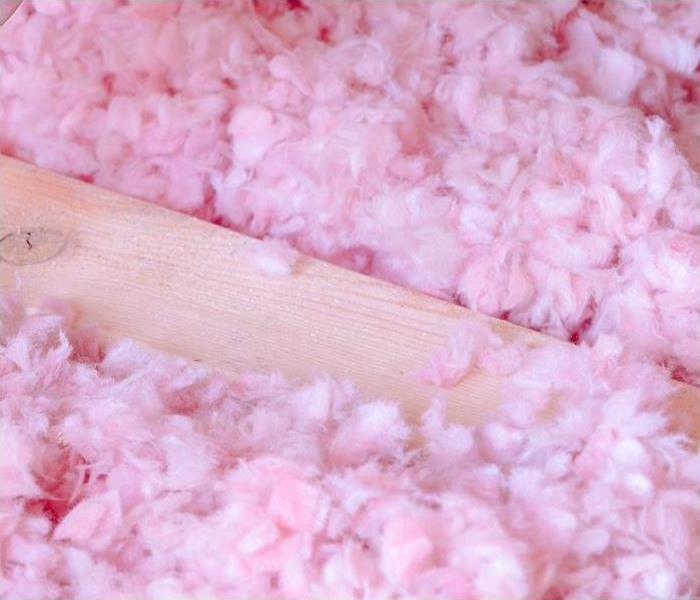 Contact the water damage professionals at SERVPRO today!
Contact the water damage professionals at SERVPRO today!
Wet insulation has a distinct pungent odor.
Fiberglass insulation is a great material in any home to keep warm air inside and cold air out. However, during water damage events (such as flooding, pipe burst, or sewage back-up), the fiberglass insulation will be damaged and soak up water like a sponge, leading to mold growth if not dried quickly. This blog post discusses how wet insulation is one of the most common causes of mold damage and what can happen if it is not mitigated quickly.
What is insulation?
Insulation was designed for temperature regulation in a home; it will keep a home warm in the winter and cool in the summer. You can find insulation in the attic and walls of a home. Most of the time, insulation will sit in ceilings and walls but can also be found in the floors above vented crawl spaces.
The most common type of insulation found in a property is fiberglass insulation. Fiberglass insulation is a type of insulation made up of small glass fibers that are compressed together.
Wet insulation issues
Wet fiberglass material soaks up water just as easily as a sponge does; this is why water damage events such as flooding will lead to mold growth when not dried quickly.
It's important to remove any wet materials from an affected area so mold won't grow. When mold is left to grow for too long, the property will end up resulting in structural issues like wood rot, which can devalue your home.
Wet materials need access to air and dehumidification to be adequately dried out, and IICRC certified restorers know how to adequately dry a property that has been damaged by water.
In some cases, a restoration professional may decide that it will be better to throw out all wet insulation rather than trying to salvage it. However, keep in mind that wet insulation that comes in contact with contaminated water should be removed and disposed of as soon as possible.
Signs of wet insulation
The easiest way to tell that a property has wet insulation is to inspect the drywall covering the insulation after a basement flood or water damage event. If the drywall is saturated, it will be safe to assume that the insulation behind the wall is also wet.
Restoration professionals use penetrating moisture meters to test the moisture levels in drywall and the insulation. After the penetrating moisture meter confirms that the drywall and insulation are wet, the restoration professional will remove all the water-damaged drywall and wet insulation to prevent mold growth.
Signs of moldy insulation
Moldy insulation will appear to have dark or black spots and will have a very distinct smell. It is best to call water damage restoration professionals quickly to avoid mold growth.
A restoration company your can trust
Through the years, the professionals at SERVPRO of East Dayton/Beavercreek have proven themselves to be the go-to water restoration company when it comes to water damage in Dayton, Ohio.
SERVPRO of East Dayton/Beavercreek prides themselves on their ability to deliver fast services without compromising customer experience. When you choose to call SERVPRO for water damage services, you will receive a tailored drying plan and a fast responding team to ensure that your property is dried as quickly as possible.
SERVPRO of East Dayton/Beavercreek is fully equipped with industry-standard equipment, including:
All of the professionals at SERVPRO of East Dayton/Beavercreek have gone through extensive training by the IICRC.
Please contact us today if you are in the middle of a water damage disaster and need emergency services or want to inspect your insulation for mold growth.
5 Actionable Steps To Take When You Have A Water Damaged Ceiling
5/31/2021 (Permalink)
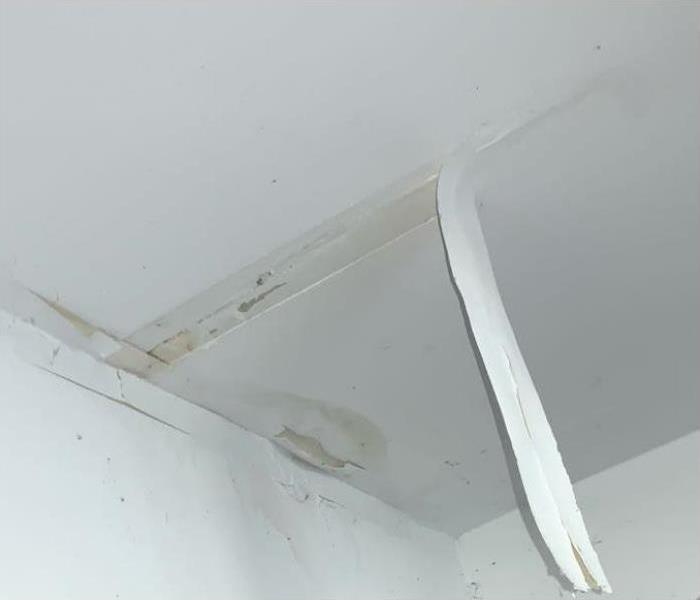 Contact water damage professionals that are ready for any size disaster!
Contact water damage professionals that are ready for any size disaster!
Ceiling water damages deserve undivided attention.
There is nothing more horrifying than sitting in your living room one day, and you notice an unsightly brown projection beginning to peel from your ceiling. You may be wondering why there is a brown spot and how it may have gotten there. After a few Google searches, you realize that your ceiling has been damaged by water. Instead of worrying, start thinking about what action steps to take next.
Although any water damage situation can be stressful, there is good news; if you are reading this post, you likely recognized the sign of ceiling water damage early on. Finding ceiling water damage at early stages allows a homeowner to avert further structural damages.
In this blog post, we will be going over five actionable steps you, as a property owner, should take after finding out that you have a ceiling water damage issue.
Step 1: Address your water damage ceiling situation calmly.
When it comes to water damage repair, we tend to be distressed over the situation and rashly make decisions. Oversee the damage calmly and make an informed decision whether to address it yourself or to seek professional help. It is essential to be aware that quickly addressing a water damage situation can save a property owner from more significant expenses.
Step 2: Find the source of the water damaged ceiling.
There are two primary sources of why a water damaged ceiling may be occurring. The first possible cause of the water damaged ceiling may be the result of a roof leak. A clear sign that you have a roof leak will be clearly shown when your ceiling only gets wet after rainfall.
Another likely cause of a water damaged ceiling is when a property has a pipe brake or defective plumbing pipes. Malfunctioning plumbing piping will lead to water damage when a pipe begins to drip in between the drywall.
Step 3: Remove all water damaged materials.
When you have a water damaged ceiling, remove all the wet materials so that mold will have a less likely chance to grow. There is more to a water damaged ceiling than wet drywall. Inside your wet drywall will also be wet insulation; both materials need to be removed.
Step 4: Check for signs of mold damage.
Whenever there is impending water damage, one of the likely outcomes to watch out for is mold growth. Mold is a type of fungi that can live and thrive anywhere with a little bit of moisture. The professionals at SERVPRO know they have a 48-hour window to mitigate water damage before mold begins to grow. When you find mold, it is essential to contact a professional in mold remediation to ensure a healthy environment in your home.
Step 5: Dry the water damaged ceiling
Once you have isolated and located the source, it is time to dry the damaged area. Water damage professionals use fans and dehumidifiers to dry water-damaged regions thoroughly. You can rent drying equipment at a hardware store, but it is best to hire professionals specializing in water damage repair services. Water restorers have all the necessary drying equipment and disinfectants to ensure your property is ready to be put back "Like it never even happened."
When to call the professionals at SERVPRO
As you learned throughout this blog post, ceiling water damage goes beyond aesthetics: mold can develop and cause severe structural damage. It is best to call the professionals at SERVPRO of East Dayton/Beavercreek at the first sign of ceiling water damage. The professionals will ensure your water damaged ceiling is mitigated correctly and not prone to future mold growth.
The professionals at SERVPRO have witnessed many situations where a property owner has tried to mitigate the water damages on their own, causing more severe issues in the future.
Water damage mitigation is more than just placing drying equipment. The professionals at SERVPRO go through extensive water damage training to ensure all moisture is at proper levels and the property is free from future mold growth.
Contact us today to schedule an inspection when you think or know your property has a water damage issue. We are available 24/7 every day of the year for disaster mitigation!
How Can A Clogged Dishwasher Drain Hose Cause Water Damage?
5/17/2021 (Permalink)
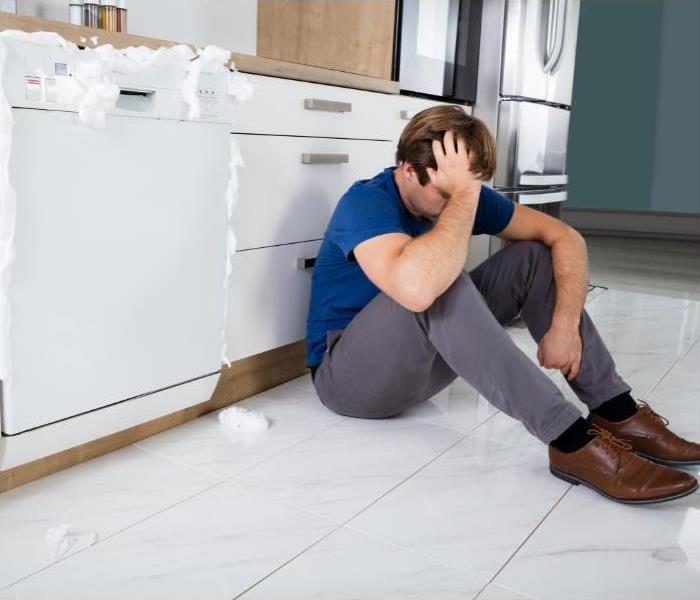 Call SERVPRO for kitchen water damage restoration services!
Call SERVPRO for kitchen water damage restoration services!
The water damage professionals at SERVPRO have restored many water damages from a clogged dishwasher drain hose.
Dishwashers are an easy and comfortable part of our lives in our modern society. We load the dishwasher with the day's dishes, run a cleaning loop, and then spend the next hour doing other things. It is easy for us to take getting a functioning dishwasher for granted before it suddenly stops working.
A common reason for a dishwasher to malfunction is when food, paper, and other debris collect in your dishwasher drain hose and cause a clog. A clogged dishwasher drain hose will trigger backups and limit a dishwasher's efficiency.
If your dishwasher develops a clog of some kind, you might be in for some severe problems, mainly when it overflows. Dishwasher water damage does not end here; if it goes unnoticed for long, it can cost you serious secondary damages.
In this blog post, we will go over the early signs to look for when you think your dishwasher drain hose is clogged, actionable steps to unclog the drain hose, and who to call for water damage restoration.
What does a clogged dishwasher drain hose look like?
Underneath your dishwasher unit, there is a drain hose that can crack, clog, and deteriorate over time, causing a water damage leak. Early warning signs of dishwasher leakage are frequently found under and behind the unit, where plumbing connections are hidden.
To ensure a well-functioning dishwasher, you should remove the front kickplate two to three times a year and search beneath the dishwasher for dripping or other signs of water leakage. It is best to check the unit for a clogged hose, both when it is turned off and filling.
When a clogged dishwasher drain hose goes unnoticed and untreated, it can easily become the cause of severe water damage to your kitchen and home in little time.
3 Early signs of a clogged dishwasher drain hose
1) Loud noises
Dishwashers are not known for being very silent, but the sound they produce is usually pretty predictable. If you hear uncommon noises coming from your dishwasher, it may be due to a clog.
2) Gurgling
It's never a positive thing if the drains are gurgling. Although this does not always indicate that you are dealing with a major plumbing problem, it does indicate that something isn't quite right. If you hear gurgling, it means there's a clog, or at least a partial clog, somewhere in either your drain hose or pipe.
3) Water overflow
When the dishwasher backs up into the kitchen sink, you know something is wrong. A dishwasher overflow indicates that the water is unable to flow due to a clogged drain hose.
How to unclog a dishwasher drain hose
If you've figured out what's causing your dishwasher hose to clog, make sure you're prepared to unclog your drains. Below we are going to be going over a way to unclog your dishwasher drain hose, but remember that it is always wise to hire a local plumbing professional with the right knowledge.
Tools you may need:
- Drain auger or snake.
- Gloves.
- Bucket
- Vinegar
- Phillips head/flathead screwdriver
- Baking soda
(Before starting any dishwasher repairs, unplug the unit!)
To start the unclogging process, you will want to remove the dish racks and then remove the drain grate with a screwdriver. Manually remove any visible debris and then use a mixture of baking soda and vinegar and let it sit for 15-20 minutes. After you let the solution sit, you can add boiling water down the drain hose. Reattach and reinsert the rack and grate and check to see if the dishwasher is properly draining.
Contact SERVPRO for dishwasher water damage restoration
At SERVPRO, we believe that no water damage is the best kind of water damage. You can count on the IICRC certified professionals at SERVPRO of East Dayton/Beavercreek when your dishwasher malfunctions and causes water damage throughout your home. Your kitchen will be back in a pre-water damage state in no time with the help of our experts.
Contact us today! We offer 24/7 emergency services to all property owners throughout the greater Dayton area.
5 Steps To Take When a Pipe Breaks
11/30/2020 (Permalink)
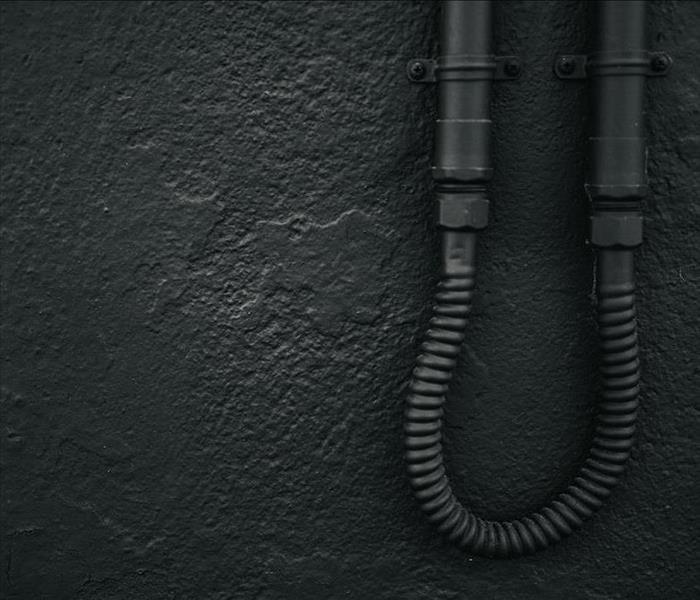 Call SERVPRO ASAP when you first notice water damage!
Call SERVPRO ASAP when you first notice water damage!
Time is not on your side when your home has water damage
A broken pipe in your home can cause a massive headache because, typically, it will result in water damage. We want our locals to be mindful and call a plumber when pipes in their property make noise or seem not to be working correctly.
SERVPRO of East Dayton/Beavercreek is an IICRC certified water damage firm; the following five steps are steps that they believe in reducing the size of water damages from a broken water pipe:
1) Shut Off The Water
The first thing you need to do is locate your main water shut off valve and immediately turn off the water. Shutting off the main water line will avoid any extra water damage. Once you have turned off the water supply, turn on a couple of faucets in your home that are not linked to the damaged pipe; this way, the remaining water in the pipes will come out and relieve the water pressure.
Depending on the water leak location, it might be useful to turn the electricity supply off.
2) Contact A Plumber
It is highly recommended that you call a local plumber to handle fixing any broken pipes. Calling a plumber will allow running water to be turned back on and to have your home or business back to a functioning manner.
3) Remove The Water
After you contact a local plumber, you can start cleaning up any water that might have leaked inside the property to prevent any further damages or possible mold. It is good to call a water restoration company even if the broken pipe causes a small water leak. No matter the size, a water restoration company like SERVPRO will be able to handle both water and mold damage properly. They will install Air Movers and Dehumidifiers to ensure that your home is dry.
4) Get Air In Tight Spaces
Most of the time, your pipes are located behind walls. Without the knowledge of drying techniques, it will be hard to get air behind a wall. If you have pipes enclosed behind walls, cabinets, and doors, you should try to get air to pass through. Airflow will help move water particles into the air and be removed by a dehumidifier.
5) Contact Your Insurance Company
Nine out of ten times, SERVPRO has seen water damage from a broken pipe covered by the homeowner's insurance company. The best part about hiring SERVPRO for all water damage restoration services is that they will work with your insurance company to ensure you're getting the proper coverage out of your claim.
Call SERVPRO Professionals
Right after a pipe breaks in your home, you can skip all steps and call SERVPRO directly to save time. SERVPRO has a water damage team available 24/7 and has built relationships with the best plumbing vendors in Dayton, OH. Remember, it is always better to be on the safe side and avoid any mold damages from a small water leak. We will take care of the work, contact your insurance company, and completely restore any damage caused by water and/or mold.
Call us at (937) 228-3433.
More About Dayton
3 Vital Reasons Why You Need a Professional Sewer Restoration Company To Cleanup a Sewer Backup
10/19/2020 (Permalink)
 Sewage restoration water contains bacteria and other pathogens.
Sewage restoration water contains bacteria and other pathogens.
The professionals at SERVPRO know that sewer water "category 3 water" contains microbes such as bacteria and other pathogens. Countless times we have heard about poorly mitigated sewage water causing severe illnesses. It is best for sewer backup restoration to occur immediately to prevent further damages.
This post will go over three things that sewer backup restoration professionals look for during a category 3 water loss.
Mishandling a Category 3 water damage can be costly and potentially hazardous. Sewage restoration needs to be taken seriously by all involved parties. It may be overwhelming at first, but working with the right sewer backup restoration company will make the process less stressful.
Before we get started, please note that we do not recommend you do sewer restoration yourself. Please leave it to a category 3 water professional!
Why Choose SERVPRO For Sewer Restoration
You will want to hire SERVPRO for the property damage because they are qualified to perform sewer damage cleanup. All of the SERVPRO heroes have been trained and follow the IICRC S500 Standard of Care for category 3 water damage restoration. Category 3 water is “grossly contaminated and may contain pathogenic, toxigenic or other harmful agents” (IICRC S500).
The variables involved in sewer restoration create additional challenges in the cleanup process. The typical general contractors, handymen, and plumbers are not trained on sewage restoration processes.
3 Vital Reasons To Hire A Professional Sewer Restoration Company
1) Sewer Restoration Professionals Will Find the Cause
As soon as the emergency plumbing restoration professionals arrive on-site, they will begin to investigate the cause of the loss. The professionals at SERVPRO have seen the common cause of a category 3 water loss to be a faulty piping connection to your home. Having the guidance of an emergency plumbing restoration company by your side will be helpful.
2) Sewer Restoration Professionals Disinfect the Right Way
It is common to see category 3 water to contain urine and feces. An emergency plumbing restoration professional will prioritize avoiding cross-contamination during the sewer backup restoration process to prevent illness from toxic biohazards.
3) Sewer Restoration Professionals Prevent Mold
Category 3 water paired with humidity makes an excellent breeding ground for mold growth. There is nothing worse than pairing a sewer restoration job with mold damage. A professional sewage restoration company will ensure that the area is dried correctly, well ventilated, and treated with antimicrobial to prevent future mold growth.
Outside of a professional emergency plumbing restoration company knowing how to find the cause, properly disinfect, and prevent mold, they also know what steps need to occur to keep all parties involved safe.
Sewer Restoration Cleaning Steps
- Wear PPE - Wearing a full PPE suit is essential when dealing with category 3 water. Waterproof gloves and rubber boots will ensure that the sewage does not spread and does not come in direct contact with the sewer restoration professional.
- Bag Damaged Materials – It is best practice to start by removing all wet carpet and padding to be disposed of appropriately. You will see the sewer restoration professionals use bags to pack up all porous materials such as clothes, cardboard, and books. Porous materials that have been in contact with category 3 water are not salvageable.
- Remove Salvageable Items – Salvageable items include plastic items, dishes, toys, and glass furniture. All salvageable items should be removed and taken to an offsite location for cleaning.
- Use Ciontaminate Barriers – It is essential to prevent the spread of sewage to places that have not been affected by category 3 water. Sewer restoration professionals will use containment barriers to contain the areas that have been affected.
- Start the Cleanup – After removing all the salvageable and non- salvageable items, the water-extracting process can occur.
- Dry The Damaged Area – The sewer restoration professionals will use dehumidifiers and fans to remove all the water particles in the air. In some cases, it is a good idea to open your home's windows to allow fresh air to help with the smell.
Conclusion
As you have learned today, hiring a professional sewer restoration company to do the cleanup will help you rest easy, knowing that the category 3 water cleanup will mitigate all sewage dirt from your home. Sewage restoration professionals have the proper equipment to dry and prevent mold growth. Only the highest quality of antimicrobial products will keep your home safe from fungi, parasites, pathogens, and bacteria caused by category 3 water.
SERVPRO of East Dayton/Beavercreek performs sewer restoration services throughout Ohio in the greater Dayton, Xenia, Beavercreek, Riverside, and Spring Valley regions. We are available 24/7 for emergency sewer backup restoration.
Xenia Water Bill Skyrockets After Water Damage
10/5/2020 (Permalink)
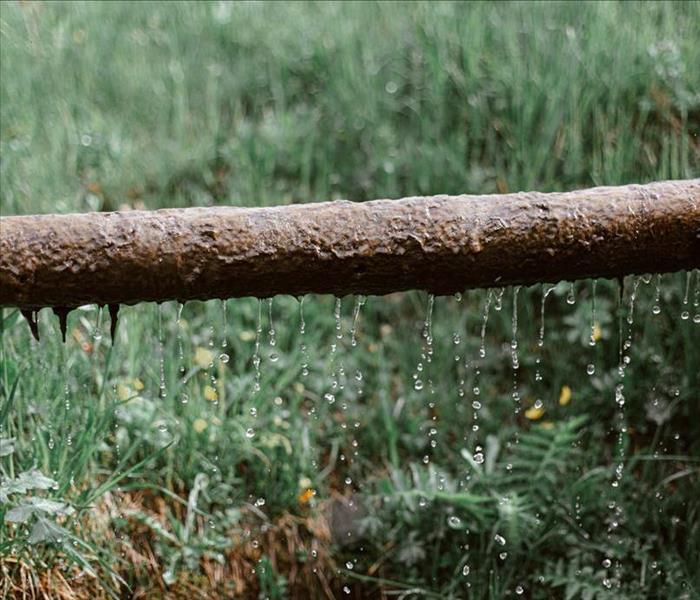 High water bills can be caused from underground pipe leaks
High water bills can be caused from underground pipe leaks
A small leak in an underground pipe can cause residents to have an outrageously expensive payment for their Xenia water bill.
There are many reasons why a Xenia city water bill may be high. A reason that SERVPRO has seen a high Xenia water bill is due to an underground pipe burst. An underground pipe burst can go unnoticed for months especially when the home has a crawl space.
Contact the professionals at SERVPRO ASAP if your home or business has water damage. Our teams are ready to tackle any size disaster.
Crawl Space Water Damage
A crawl space is an area under a xenia home. They are typically 1 to 3 feet high located between the ground and the home's first floor. The disadvantage of a crawl space is that they can harbor moisture, especially when a pipe bursts. When water damage from a pipe burst goes unnoticed, you can expect there to be a mold issue as well.
A leak or water usage change most often results in a high Xenia water bill payment. The most common causes of high Xenia water bills include the following.
Causes of High Xenia Water Bills
A high Xenia water bill payment is most often caused by a leak or a change in water usage. The most common causes of high Xenia water bills include:
- A leaking toilet
- A toilet that continues to run after being flushed
- A dripping faucet
- Filling of a swimming pool
- Watering the lawn
- Automated irrigation systems
- Water-cooled air conditioners
- A broken water pipe
As you can see, there are many causes for a high Xenia water bill. We have witnessed many local Xenia residents upset after water damage. They have all the reasons to be upset, too; they will have to pay for water damage restoration and the wasted water.
SERVPRO cares about the environment and is never happy to hear about wasted water from an underground pipe bursting.
Paying A High Xenia Water Bill
A typical family household of four uses about 4000-5000 gallons of water a month. More water consumption occurs during the summer season due to pools, gardening, and watering of lawns.
When you receive a high Xenia water bill, you must pay it as soon as possible to avoid any late fees. You can pay a Xenia rural water bill pay online or mail a check to the water utility center.
In Conclusion
If you are a resident of Xenia who keeps receiving an abnormal Xenia water bill, it is important to call SERVPRO of East Dayton/Beavercreek to inspect your home. One of our IICRC certified professionals will come out and check your crawl space and any other potential areas where water damage may be present.
SERVPRO is an industry leader in the restoration niche but can provide construction services as well. When water damage occurs, the SERVPRO Ohio team will come out and mitigate the water damage and then rebuild your property “Like it never even happened.”
Call us at (937) 228-3433.
More About Xenia
State Farm Covers Water Damage To Your Home
9/7/2020 (Permalink)
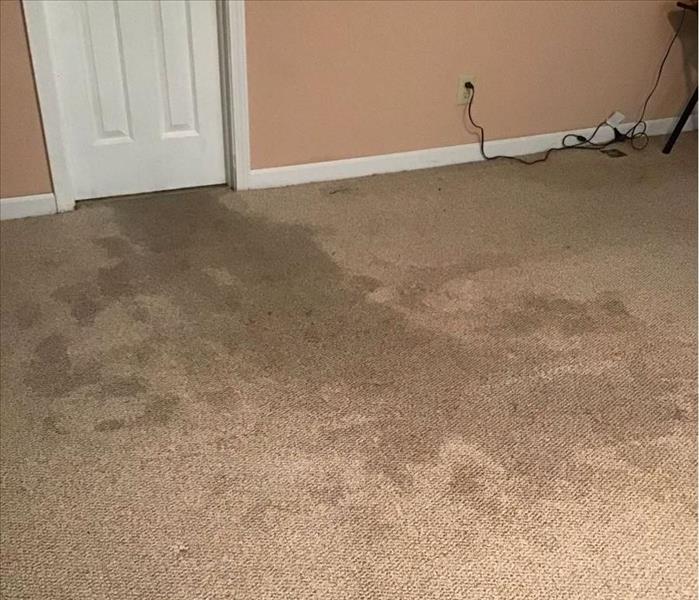 Our IICRC certified firm is available 24/7 to help mitigate your water damages.
Our IICRC certified firm is available 24/7 to help mitigate your water damages.
State Farm has added ambiguous language added to their water damage coverage clause. When water damage occurs in your home, it may be more challenging to get the money needed to restore your home.
Fortunately, the team at SERVPRO of East Dayton/Beavercreek has over twenty years of experience working in insurance damage repairs. The SERVPRO team will work closely with homeowners and have built relationships with insurance companies like State Farm to ensure that everyone is treated fairly regarding all water damage losses.
How Do Insurers Typically Determine Coverage?
A standard home insurance policy requires water damage to be sudden and internal. The team at SERVPRO has typically seen covered water damages that have occurred from:
- Rain and storm damage
- Broken plumbing such as burst pipes, frozen plumbing, faulty plumbing, overflowing (toilet, tubs, washing machines)
- Water damage from the fire department
- A roof leak
Difficult water damage coverages
In some cases, water damages are more challenging to be covered because they are not accidental or unexpected. We have seen homeowners be declined coverage due to neglect and lack of home maintenance. If your home has water damage resulting from negligence, then most likely, you will be the one having to pay for the repairs.
Here are the situations where a homeowner may have more difficulty getting State Farm to cover the water damage restoration:
- Flooding
- Ground seepage
- Poorly-maintained pipes leading to leaks
Many Dayton homeowners are not aware that their standard policy won’t cover any water damage resulting from a flood. We suggest that you purchase additional flood damage insurance if your home is susceptible to flooding.
SERVPRO Relationships With Insurances
SERVPRO has a partnership with insurance companies like State Farm and Allstate. With this partnership, we have an easier time getting water damage claims approved over other restoration companies.
We have heard stories about homeowners using other restoration companies that do not have a partnership with an insurance company and getting their claims denied even after the work has been performed. In some cases, we understand that the damages need to be cleaned up ASAP, but please ensure that the claim is approved prior to work being performed. The last thing that we want a homeowner to go through is a water loss and paying for the loss out of pocket.
By having a strong relationship with Statefarm, we can not guarantee that your insurance claim will get approved. Still, we will say that we have a higher chance of quickly getting water damage claims approved over other restoration companies.
We rarely run into problems with insurance companies that have partnerships with us.
As stated at the beginning of this post, Statefarm and other insurance companies have ambiguous language in their policies. We think it is essential for homeowners to be aware of the strong relationships that we have with insurance companies to avoid getting the runaround from an insurance adjuster.
Call the professionals at SERVPRO to help you when your home or business suffers from a water loss. We are available 24/7 and open 365 days a year!
Call us at (937) 228-3433
More About Dayton
5 Actionable Steps To Take When Water Damage Occurs in Miamisburg, OH
6/29/2020 (Permalink)
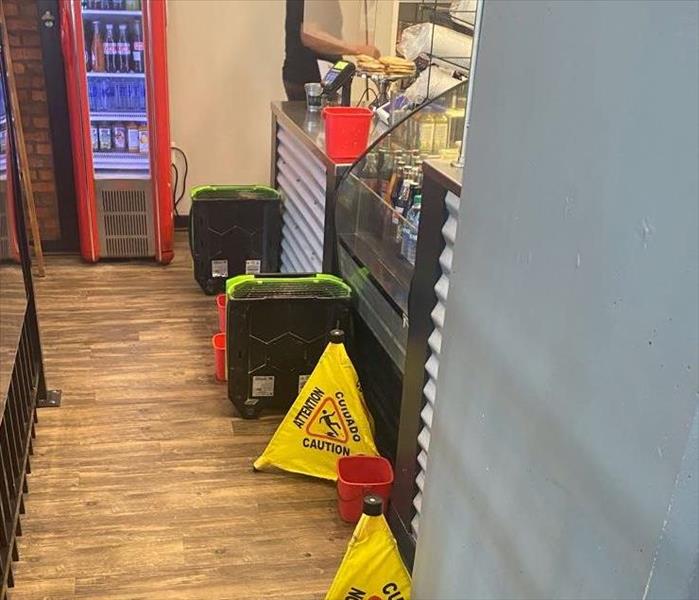 We are here to help fight water damage in Miamisburg
We are here to help fight water damage in Miamisburg
SERVPRO Professionals Perform Restoration for Commercial Water Loss in Miamisburg Ohio
This past spring, the residents of Miamisburg knew that a three-day storm left many with flooded basements and newfound leaks. Our phones were non stop ringing with a total count of two hundred calls on the second day of rainfall. When heavy rain occurs, we place ourselves in what we call a storm response. Our professionals know that during a storm event, they can expect to work longer hours to help the local homeowners fight water damage.
Miamisburg Restaurant Water Damage
In the image above, you can see a couple of air movers placed in a Miamisburg restaurant. The restaurant had water damage caused by a leak in the roof that made its way through the walls. This particular drying setup was used to help dry the ceiling as quickly as possible so that the business could begin serving customers again.
When a local restaurant suffers from a water loss, we do our best to get the building dry as quickly as possible. We know that small business owners own many restaurants and that revenue is lost every day that they are closed. In this particular incident, the owner was fortunate because we received the call after business hours allowing us to do all demolition overnight. The owner was able to keep their restaurant open the whole time while we were drying the property.
Insurance covers commercial water damage.
Anytime water damage affects a Miamisburg home or business, we let our customers know that they have two options for paying for the damages.
- Pay for the damages out of pocket
- Submit a claim to their insurance company
Paying for damages out of pocket
The typical trend that we have noticed here at SERVPRO Miamisburg is that smaller water damages usually are paid for by the owner. An owner may decide to pay for the water loss out of pocket because insurance companies may increase your insurance rates after a claim.
Submitting a claim
More substantial water losses are advised to be forwarded to the owner's insurance provider. The reason that we suggest this is because the damages can cost tens of thousands of dollars. In the case of the Miamisburg restaurant, the small business could not pay for the damages without help from insurance because of the extensive damage that the ceiling had undergone.
Appliances and electronics affected by water damage
We are here to help if appliances (like a point of sales system) are affected by a water loss. We do not take care of water-damaged electronics in-house, but we have a preferred vendor to fix broken appliances. Please note that our preferred vendor can't save all appliances. In some cases, it is better to buy new appliances.
Miamisburg Restoration Contact
SERVPRO of East Dayton/Beavercreek proudly serves the Miamisburg, OH community. We have been called for small water losses where a basement has had a flood to significant tornado damage losses. We want our Miamisburg residents to know that no matter what the job's size may be, we can help every step of the way. If your home or business has suffered from recent water damage, please contact our office ASAP at (937) 228-3433.
More about the city of Miamisburg.
Three Common Home Appliances That Cause Water Damage
6/15/2020 (Permalink)
Water damage can happen from multiple different appliances in your home.
We want our Dayton homeowners to feel safe knowing that their appliances are working correctly to avoid any potential home water damage. To ensure that your appliances are in good working condition, we suggest that you get all of your appliances checked at a minimum of once a year.
Home appliances that need to be checked
Washing Machines
When a home washing machine happens to have a small leak, it can appear to be a small issue. Although a small leak seems to be a minor, it should not be ignored. We have experienced small pinhole leaks in a water supply line that have broken out into an all-out basement flood. For best safety practices to prevent water damage, it is best to check the connecting hoses leading to your washing machine a couple of times per year.
In some cases, our customers install an automatic shutoff valve to the water supply line for their washing machines. A shut off valve can help save a home from 500 gallons of water damage. Most water shut off valves on washing machines work because they automatically shut the water entering the washing machine once a full cycle is complete. The valve will remain closed until the next person is looking to wash the laundry.
Refrigerators with plumbing
We all appreciate the convenience of an automatic ice maker in our kitchens. But did you know it can also be the culprit of household floods? Our SERVPRO crews have had to clean water damages caused by the water line that supplies an ice maker. When the water lines get damaged, they can leak or, worse yet, become completely unattached. We know it might be a hassle to get behind your home's refrigerator, but it is essential to waterline periodically for crimps and make sure the valve connection is secure. We recommend our customers leave a four-inch gap between the refrigerator and the wall for safety from water damage. This will allow easy access to pull out the fridge and prevent future crimping in your water line.
Dishwashers
The last known home appliance that can cause severe water damage comes from dishwashers. This household appliance has a supply line just like refrigerators and washing machines. If a dishwasher water supply line was to burst, you could guarantee that your kitchen will be filled with water after a wash and rinse cycle. In some of our more severe water damages caused by dishwashers, we have seen a dishwasher back up. Backup typically occurs when debris has clogged the drain, and the water has nowhere to go but inside your home.
SERVPRO of East Dayton can't emphasize enough how vital yearly routine inspection of the hoses and connections can save you significant repair costs. If your Dayton home falls victim to a water emergency, time is of the essence. Contact SERVPRO of East Dayton/Beavercreek ASAP. Our experienced IICRC trained technicians are available 24/7 for all home restoration needs. Call us today at (937) 228-3433.
For more information about Dayton
How Does Water Damage Lead to Mold Growth in Dayton?
5/11/2020 (Permalink)
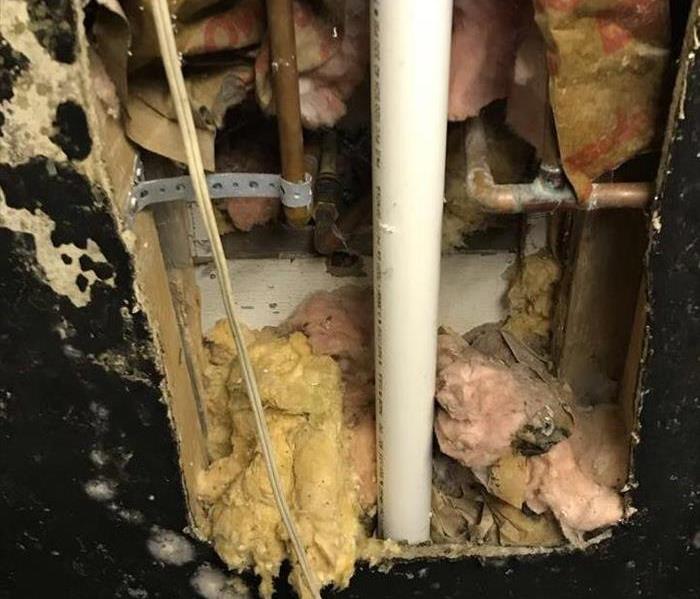 Understanding how mold grows is helpful in its prevention.
Understanding how mold grows is helpful in its prevention.
At SERVPRO, we care about your health and well-being. It’s no small matter when water damage occurs in a Dayton property. No matter the source whether a storm, leak, or natural disaster, water damage leaves a lasting impression on the areas it touches. This is why it is important to know how to clean your how after water damage. When water damage is not handled by restoration professionals it can leave more costly damages that require full demolition.
How water damage impacts
Water is excellent at finding its way into any and all possible places it can fit from the walls to the carpet to the foundation itself. If water is not properly cleaned up and dried out it can leave behind a foundation for other problems, and one, in particular, is black mold growth.
What is black mold?
Stachybotrys chartarum is the type of mold often called black mold. Like many types of mold growth, black mold produces allergens and irritants. It is important that any homeowner or property manager treats any mold in their property with caution. Most importantly when mold is visible it is important to stay out of affected areas until a mold professional comes to assess the damage.
Steps to Avoid Mold Growth
- Controlling the amount of moisture throughout your property includes keeping areas dry and not allowing moisture to sit for long amounts of time.
- Clean up spills on the floor, clean out your gutters, and keep air conditioning drip pans clean.
- If there are generally more moist areas in your Dayton home or business than others, you can also use things such as a dehumidifier to remove the moisture from the air effectively.
Understanding mold growth helps to prevent it. A large cause of mold in the first place is not properly repairing, cleaning, and drying out space after water gets into it. This can include things such as plumbing or roofing leaks. Just because the leak has been stopped doesn’t mean that pooled water has cleared. It is best after any water damage to have a professional come and inspect and properly dry out your home to ensure no mold can develop and spread.
Give SERVPRO of East Dayton/ Beavercreek a call at (937) 228-3433 for any water damage or mold removal in Dayton. Let the professionals, like the experts here at SERVPRO, help you.
What to Expect From the Water Restoration Process
4/20/2020 (Permalink)
Since every flood and water damage scenario is a little different, each one requires a unique solution tailored to the specific conditions. However, the overall water restoration process remains the same. The process begins when you give us a call. SERVPRO of East Dayton/Beavercreek is available 24 hours a day for any size water emergency.
Immediate action is crucial when facing flooding or water damage and a delay of just a few hours can drastically increase the severity of water damage left behind. While water damage can be chaotic and traumatic to deal with, SERVPRO of East Dayton/Beavercreek has the expertise and experience to help you through a water damage disaster.
When you give us a call, we will ask you questions to assess the situation and determine what equipment and resources will be necessary to bring. Upon arrival at the site of water damage, we begin with a detailed inspection and damage assessment of your home or property to determine the scope of the water damage to create the best plan of action. After inspection, we will identify the source of moisture in your home or business and the type of water. When dealing with water damage, there are three types of water according to their level of contamination: “Clean Water”, “Gray Water”, and “Black Water” are used to classify how contaminated the water is so that our trained SERVPRO Professionals can restore your property to industry guidelines.
The next step of the water damage restoration process is the actual water removal. After the damage assessment and the source of moisture have been stopped, the water extraction process may begin. If the water damage is great enough to call for extensive restoration or cleaning, SERVPRO of East Dayton/Beavercreek can assist with an organized and efficient move-out to ensure your belongings are protected from any further damage. Our highly trained technicians will then begin the water removal process immediately once the surrounding area is cleared. Depending on the level of damage, our technicians may use equipment varying from industrial wet/dry vacuums to powerful submersible pumps.
Once all water has been successfully removed, the drying and dehumidification process is next. While floors and walls may appear to be dry, they will be wet to the touch as most building materials such as wood and drywall retain water once submerged. Our Professionals use measurements, temperature, and humidity to best determine how much equipment such as dehumidifiers and air movers will be needed to dry your home or business.
Most of your home or business will require professional cleaning following water damage from the floor to the ceiling. After monitoring the drying process, our technicians will clean your property’s structure, furniture, upholstery, clothing, and any other restorable items or property damaged by water. Following any kind of water damage, your home or business will require cleaning, odor removal, and sanitization depending on the scenario. Our technicians here at SERVPRO East Dayton/Beavercreek are trained to deodorize, sanitize, and dispose of damaged materials in your home or property.
The final step following a water damage disaster is the restoration of your home or business to its pre-water damage condition. This may involve minor repairs such as replacing drywall to major repairs such as the reconstruction of various rooms or areas. Our professionals will provide immediate protective measures during the water damage restoration process such as tarps and will handle rebuilding all affected areas. We are a company qualified to handle the initial damage and rebuilding of the area afterward, and can guarantee to get any building back up to full functionality.
SERVPRO of East Dayton/Beavercreek is ready to help local homeowners with flood damage. They have the advanced equipment and expertise to turn the loss around and make it, “Like it never even happened.”
Causes of Commercial Water Damage to Watch Out For
12/30/2019 (Permalink)
 Keep your building safe and your tenants happy.
Keep your building safe and your tenants happy.
There are a lot of things to consider when maintaining a commercial property. Of course, safety is managed by laws and requirements that every commercial property must maintain, however unexpected damage is still possible. One case of unexpected commercial property damage is water damage. Commercial water damage can not only be a safety threat, but be incredibly costly to repair. So here are some possible causes of commercial water damage to watch out for.
Windows with cracks or weak construction can allow leaks from weather to invade the interior of the building. Make sure windows are strong and up to date. The foundation of the building is an easy place for water damage to occur since it’s low to the ground where water runoff or storm build up can accumulate. Ensure regular check ups of the integrity of the foundation, including cracks and leaky pipes. Sprinkler systems are required in buildings for safety reasons, but nonfunctional sprinkler systems can pose a threat by unexpectedly turning on and soaking rooms. Like the other causes, make sure someone is constantly assuring the quality of the sprinkler system. The answer to all of these possible causes is to invest in a person or team who can ensure the maintenance of the commercial property.
If you own or maintain a commercial property that has experienced water damage, no matter how much, call your local SERVPRO of East Dayton at (937) 228-3433. SERVPRO of East Dayton has dealt with commercial water damage before and knows exactly how to fix and restore your commercial property to make it “Like it never even happened.”
How a Snow Day Could Affect Your Home
12/4/2019 (Permalink)
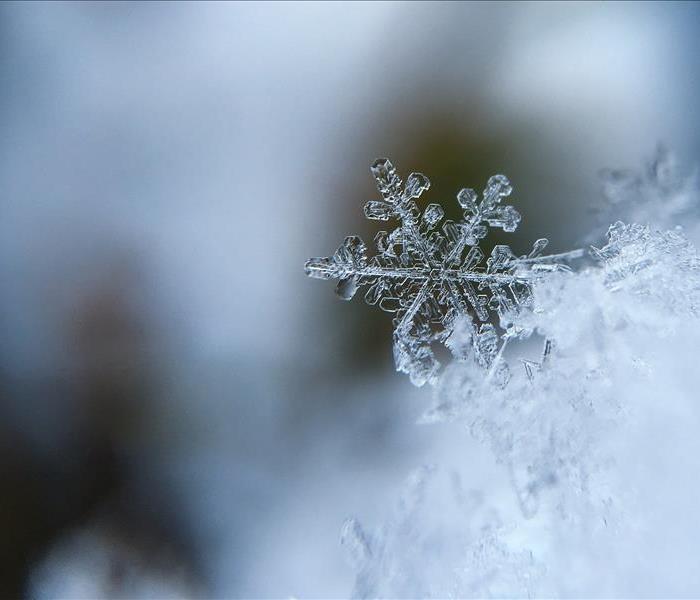 Snow is one of those aspects of life that is both beautiful and sometimes dangerous.
Snow is one of those aspects of life that is both beautiful and sometimes dangerous.
It’s pretty delightful watching our kids wander to the window and stare in awe at the snow falling outside. Especially when it sticks to the pavement, giving them the opportunity to build snowmen together or have a snowball fight. In general we perceive snowy days at nice, peaceful days. However there’s a few other things to consider as the snow falls and our homes are decorated in white. Before the first snowfall hits your area, avoid water damage danger by doing the following:
- clean out your gutters before the winter, making sure that snow can travel clearly through them when it melts.
- inspect your home’s foundation for cracks, where melting snow can sink into the home rather than the ground.
- add caulk around basement windows for proper protection.
- stock up on snow salt before winter hits, so that you’re ready for any sudden announcements of snow coming.
- make sure your tools, such as shovels or snow blowers, are ready for the upcoming season.
Why are these things so important? Well, while your home is susceptible to water damage all year long, snow poses a particularly scary threat. Since snow is the solid version of water, it can layer onto itself on top of and around the home. That means that when it is able to melt, a streamlike flow of water is bound to follow. This excess of water can seep into several parts of the home, from the roof to the foundation to the sides, and cost you and your family money that should otherwise be spent on the holidays. So make sure your home is safe from water damage. Should any water damage happen to you this upcoming snowy, winter season, call your affordable and speedy local SERVPRO of East Dayton / Beavercreek to make sure that come the holidays, you’ll be ready to host your family and spread the cheer!
Does Your Insurance Cover Water Damage?
11/11/2019 (Permalink)
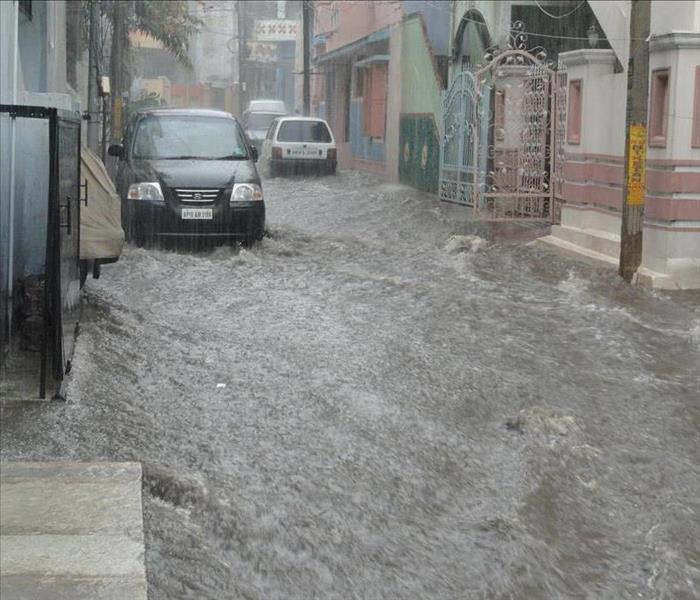 Where water damage comes from matters; it affects how damaging it is to your home.
Where water damage comes from matters; it affects how damaging it is to your home.
Approximately 98% of basements will experience water damage in their lifetime. The inevitability isn’t too surprising considering basements are underground and therefore prone to things like gravity and the consequences of whatever happens in the home above. Considering this statistic, it’s safe to say that understanding the processes of both the water damage itself and the restoration required to fix it is genuinely useful for homeowners.
Here’s what you don’t know about water damage.
First off, water damage insurance and flood insurance are different. If you live in an area not prone to floods, you don’t need to get flood insurance just to protect your home from water damage. They’re different insurance types entirely. In addition, not all water damage is actually insured. For instance, water damage related to neglection of the property may not be covered the way a sudden disaster’s effects would be. Once water damage has impacted the home, in any area, call insurance immediately. The sooner the better since they need the complete details in order to determine the cause, the damage, and therefore pay the restoration company. If you find dealing with insurance a pain, no worries. Restoration companies like, for example, SERVPRO can help you with insurance in addition to repairing the site of the water damage.
Once insurance is dealt with, there’s a few other things to consider. Some water damage, depending on the source, can be polluted and dangerous to be in or around. It is not recommended to explore the damage personally, especially if it’s a large quantity of water and in a location like the basement. In addition, the moment the water damage happens it is getting worse and worse every minute. That is why there is a sense of urgency that comes with water damage. More than the water, the dangers of water damage come with water the water causes. This includes mold growth, structural damage, destruction of personal items. The sooner the area of damage can be dried and restored, the better off the home is. The same way you wouldn’t avoid going to the doctor if a sudden pain erupted in your body, your home needs similar urgency to keep its integrity and continue to serve you and your family in a safe way.
In case of a water damage emergency, consider SERVPRO of Huber Heights. They can assist you with your insurance, be at the site within twenty-four hours, and use the most powerful possible equipment to return your home to normal in no time.
External Versus Internal Sources of Water Damage
10/29/2019 (Permalink)
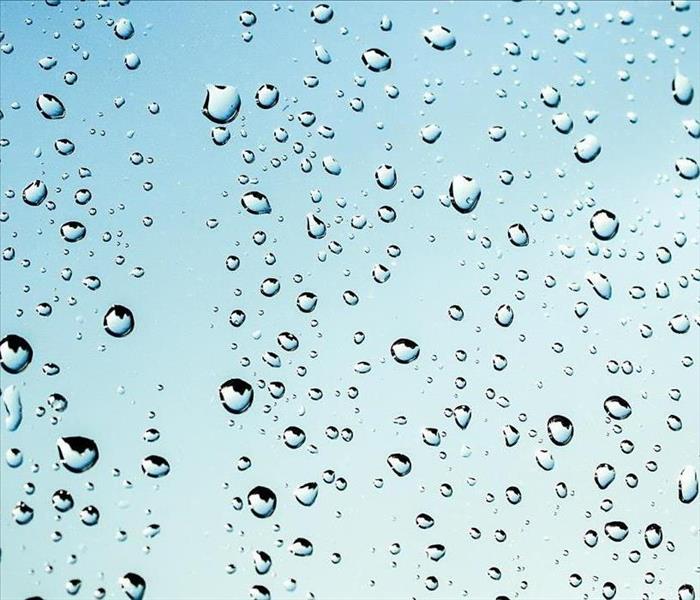 Water damage has a variety of sources.
Water damage has a variety of sources.
Water damage affects parts of the home differently, especially considering whether the source of the damage was internal or external. For example, an external leak from heavy rain is water that has crossed paths with many contaminants on its way into the home. Internal leaks, on the other hand, is often the water we would be using anyways and therefore change the concern about the water damage clean up. Safety concerns vary with each flood, leak, or build up. It also matters where in the house the water damage is located. Water damage in the ceiling can cause instability in the infrastructure of the home, and can allow breakage between the floors of the house. Water damage near the windows usually result in puddles forming under the carpet or hardwood floors, as well as within the walls surrounding the window, which can lead to peeling of the paint. While damage in this area doesn’t necessarily lead to furniture falling from the ceiling in worst case scenarios, it does force us to not only replace but repaint entire sections of the home. In all cases, a water damage assessment by a professional is necessary to know the full extent of the damage. Because SERVPRO of East Dayton and Beavercreek is a 24 hour emergency location, no matter what time you find water damage, help is just one phone call away. To have water restoration professionals able to arrive within a couple hours can take the headache out of where and how the damage occurred in the first place. SERVPRO knows how to assess and repair damage so you don’t have to.
Water Damage on Wood Versus Carpet
10/29/2019 (Permalink)
 Though the floor is not the center point of our home, the decision of what to use is just as important.
Though the floor is not the center point of our home, the decision of what to use is just as important.
Carpet and hardwood retain water differently and, as a result, require different processes in order to dry them. Carpets can very quickly become unsalvageable if they become entirely soaked or if delamination occurs. When a carpet experiences delamination, it is unable to remain adhesed to the floor and therefore must be replaced with new carpet. On the other hand, if the damage isn’t detrimental to the carpet’s adhesiveness, a wet dry vacuum can be used to help begin the drying process before water damage professionals even arrive. Carpet fibers react differently to water. Wool is one of the more expensive carpet fibers to use and yet it can be more prone to mold and mildew. Triexta is a more affordable carpet fiber and is known to non-absorbent and therefore resistant to mildew.
Wood is different because wood floors can vary in thickness and therefore damage potential. Certain types of wood handles water differently. For instance, Oak, Maple, and Cherry wood are the most commonly used for flooring and furniture due to their water resistance. On the other hand, Bamboo and Coconut Timber can be used but can require adhesives that can be undone by water damage. Wood needs to be removed in order to get rid of the moisture underneath, but depending on the integrity of the wood it can be put back after the water has been removed.
Regardless of whether water damage has been done to carpet or wood, it’s vital to hire a water damage professional to remove all the water. SERVPRO knows the best action to take for each type of floor, so if you find yourself with carpet or hardwood floor water damage make sure to call your local SERVPRO of East Dayton and Beavercreek.
Common Causes of Water Damage in Dayton
10/15/2019 (Permalink)
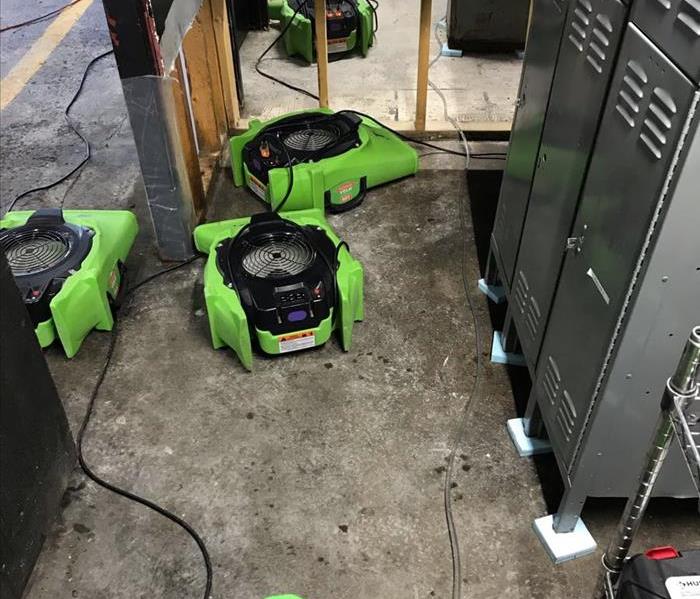 Dehumidifiers in the process of drying before SERVPRO can restore the carpet.
Dehumidifiers in the process of drying before SERVPRO can restore the carpet.
Some common sources of water damage include: broken household appliances, bursting and leaking pipes, buildup in water collection sites, plumbing system related issues, HVAC malfunctions, and weather like natural disasters. The frustrating thing is that for the most part these things are out of our control. What isn’t out of our control, however, is how we respond to these situations. Luckily for anyone in the East Dayton or Beavercreek area, professionals in water damage restoration at SERVPRO are close by and they can help you avoid the headache of long-term damage. The best thing you can do when you first find water damage is to give a call to SERVPRO. We have helped churches, schools, businesses, and homeowners alike to restore the quality of their buildings and resume life as quickly as possible. It's understandable that the weight of having water damage done to your space can feel life-stopping, but that’s what we at SERVPRO of East Dayton and Beavercreek are here to do. We make the flood clean up, mold clean up, or any water restoration needed not life stopping. Your focus belongs to keeping your life moving, our focus is on helping you do that. Regardless of the cause, ask us what we can do for you to ensure that road bumps like these don’t stop you. We won’t break the bank and we care about the work we do. Let a company that cares for your home as much as you do make it look “Like it never even happened.”
Basement damaged from water in Centerville
10/9/2019 (Permalink)
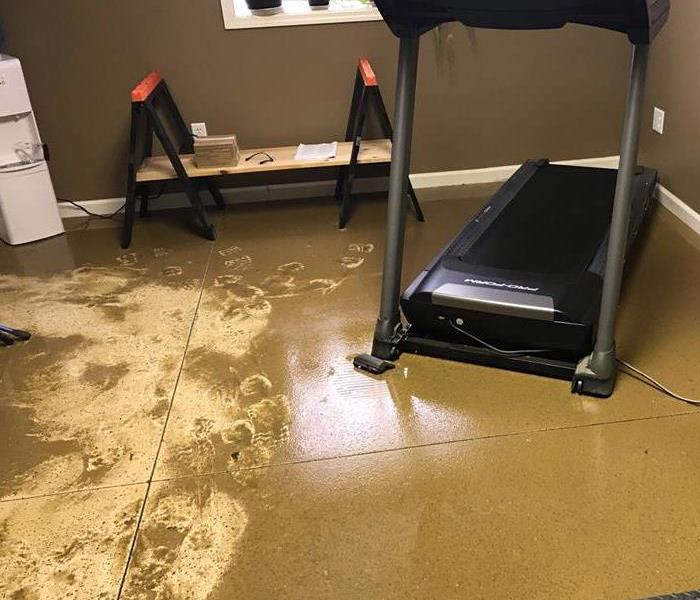 Gym equipment damaged from water damage in Centerville
Gym equipment damaged from water damage in Centerville
In the spring of 2019, a Centerville home was severely water damaged from a pipe bursting. Fortunately, our flood clean up crew was quick to respond and was on site within moments after receiving the initial water clean up call. We always make sure to let our customers know that if a flood clean up job is not produced quickly then it is possible that mold spores can grow to cause the whole job to turn into a nasty mold job. For this job, it was fortunate that the homeowners saw the water damage in time to allow our water restoration professionals to dry the basement gym quickly and effectively. This job forced our serv-pro professionals to use their water removal extractors as well as dehumidifiers and air movers. After five days of drying and demolition, the flood clean up job was finished and the customers were less stressed about the potential of mold growth.
SERVPRO Moisture Meters (Pin vs Pinless)
9/16/2019 (Permalink)
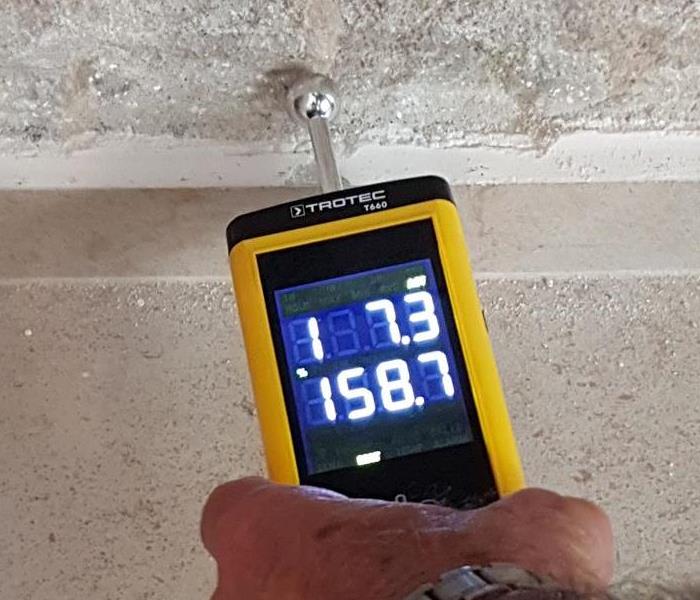 Pin Moisture Meter in-use
Pin Moisture Meter in-use
When water damage hits our customer's home or business they know that visually see water, but what many are not aware of how our team detects whether or not the drying process is complete. SERVPRO of Dayton/Beavercreek has invested in different types of moisture meters to know when the building is dry. There are two types of meters that we use, pin and pinless.
First off a pin moisture meter is more accurate, but also destructive because it requires the physical insertion of the two-pin probes into the wall or material in question.
The other type is a pinless meter. This meter has a flat sensor integrated on the back of it and is a non-invasive method. The main catch with this meter is that it only provides a relative moisture reading unlink the pin meters.
Although a pin meter is more accurate you can guarantee that both pin and pinless meters will be in our teams SERVPRO tool bags. Our IICRC water damage professionals know what meter will be most useful in each water damage situation.
What are the different categories of water damage in Dayton Ohio?
9/16/2019 (Permalink)
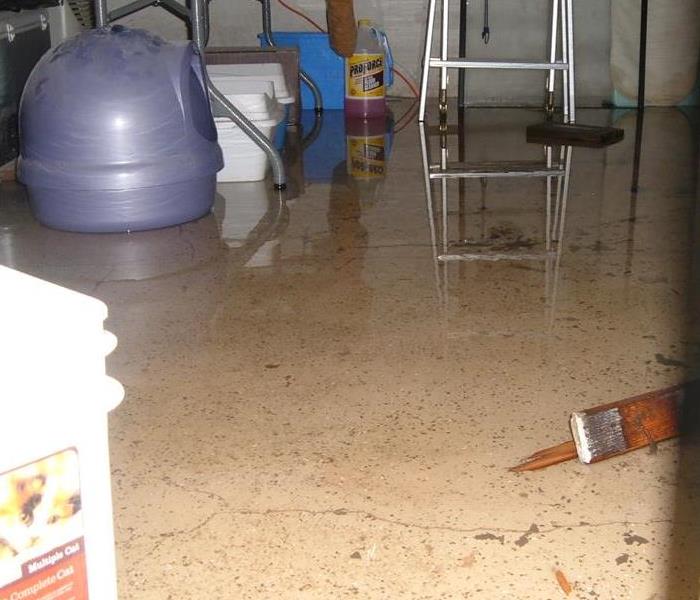 SERVPRO Category 2 Water Damage
SERVPRO Category 2 Water Damage
According to the IICRC (Institute of Inspection Cleaning and Restoration Certification), there are three different levels and classes of water damage.
Category 1 – Clean Water
Water damage from a category 1 classification is from clean and sanitary sources–water lines, faucets, toilet tanks, drinking fountains, etc. Although this water is clean, it does not come without risks. If it is not cleaned and dried quickly, it can degrade into category 2–leading to health issues to the people inhabiting the structure.
Category 2 – Grey Water
Water damage from a category 2 classification is from sources that have a level of contaminants that may cause illness or discomfort if ingested. These sources include dishwashers, washing machines, toilet overflow with urine.
Category 3 – Unsanitary
Water damage from a category 3 classification contains dangerously unsanitary contaminants. It could cause serious illness or even death if ingested. Category 3 water damage includes water from a sewer backup, flooding from rivers or streams, toilet overflow with feces, and stagnant water that has become a habitat for bacterial growth.
FYI: Each level and classification carry different levels of risk and must be cleaned differently. Our SERVPRO professionals will let you know what kind of water damage your home or business has encountered and the cleaning process.
Beavercreek Residents: We Specialize in Flooded Basement Cleanup and Restoration!
9/6/2016 (Permalink)
A basement can flood at any time, although flooding most often occurs during heavy rainfall. Basements are inherently prone to flooding because they are the lowest level of a building and are normally built partly or entirely below ground level. There are a number of reasons why your Beavercreek basement could flood, including:
- A blocked or failed sewer lateral pipe
- Heavy rain causes surface water to pool around your home
- Storm sewer backup
- Sanitary sewer backup
- Foundation drainage failure
- Water supply-line break or hot-water tank failure
- And many more
Have Questions about Basement Flooding?
Call Today - 937-228-3433
If flood water is not handled quickly and properly, it can jeopardize your health and safety, and cause severe damage to your home’s structure. Remember, the longer you wait, the worse the problem will get.
The bottom line: a flooded basement can jeopardize your health, safety, and your home’s integrity. It’s worth making a call to SERVPRO of East Dayton/Beavercreek and let our trained, professional crews handle the situation safely and correctly. We have earned the trust of hundreds of homeowners, business owners, and property professionals.
We are Flooded Basement Specialists:
- We are Available 24 hours/7 days per week
- We’re a Preferred Vendor to many National Insurance Companies
- We Bill The Insurance Directly – One Less Thing For You To Worry About
- Our Technicians are Highly-Trained in Water Restoration Techniques
- We use s500 IICRC Restoration Standards
- Advanced Inspection and Extraction Equipment
Basement Flooded? Call Us Today – We’re Ready To Help 937-228-3433



 24/7 Emergency Service
24/7 Emergency Service


























